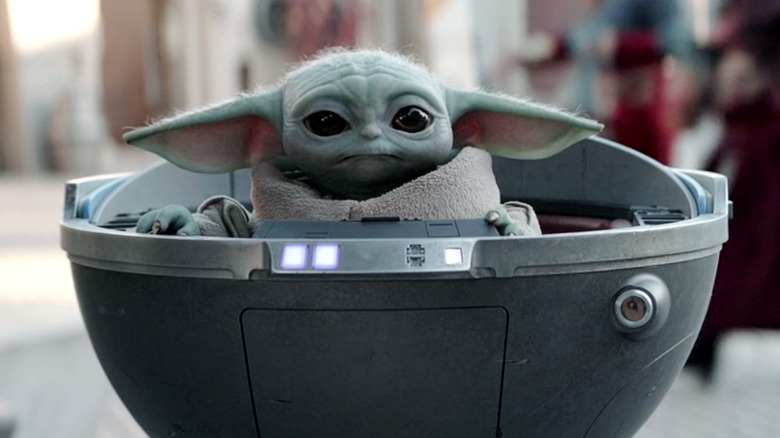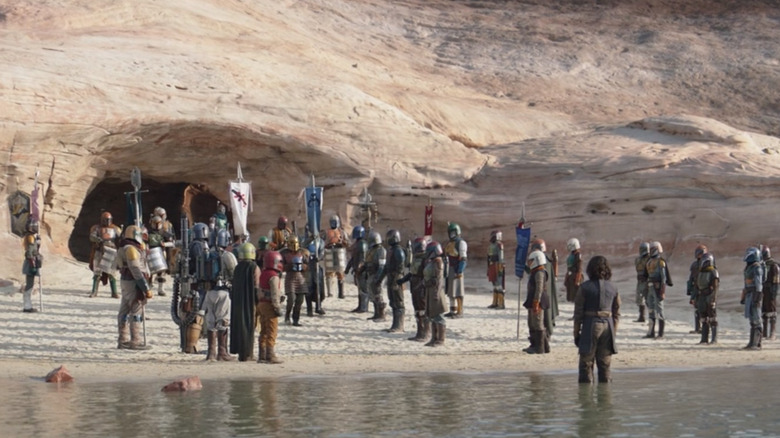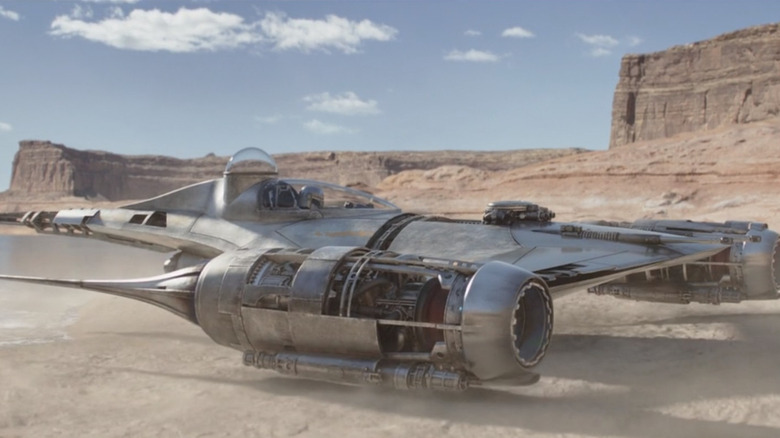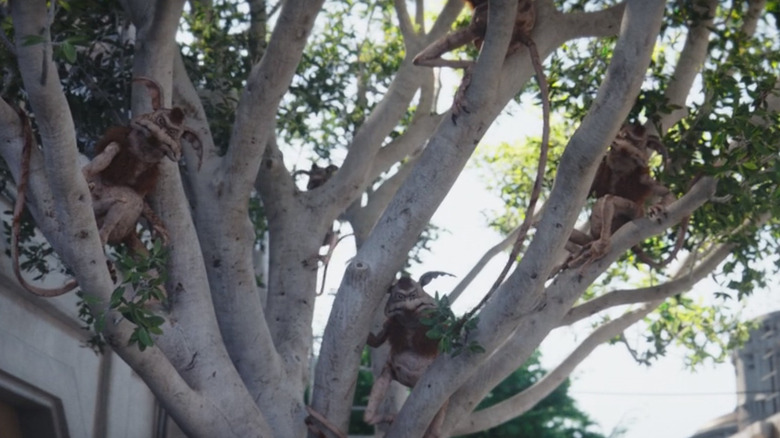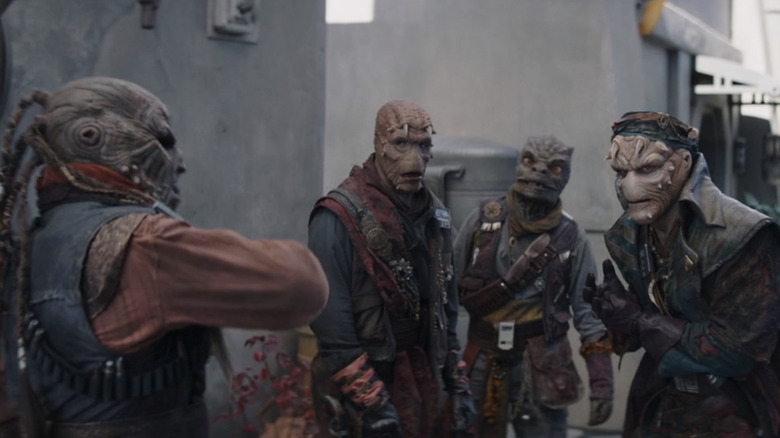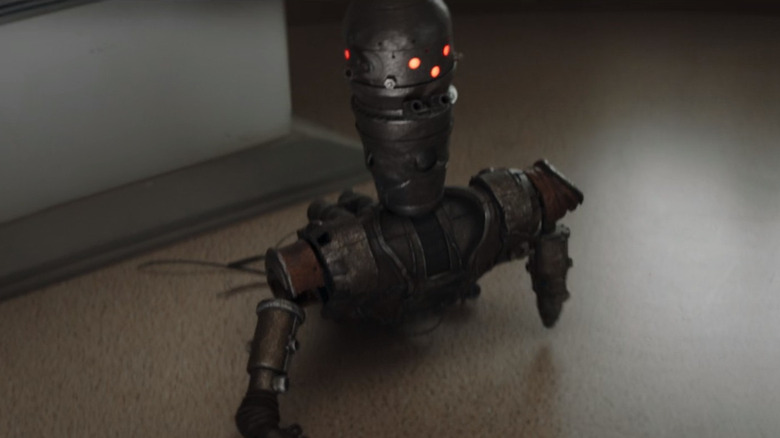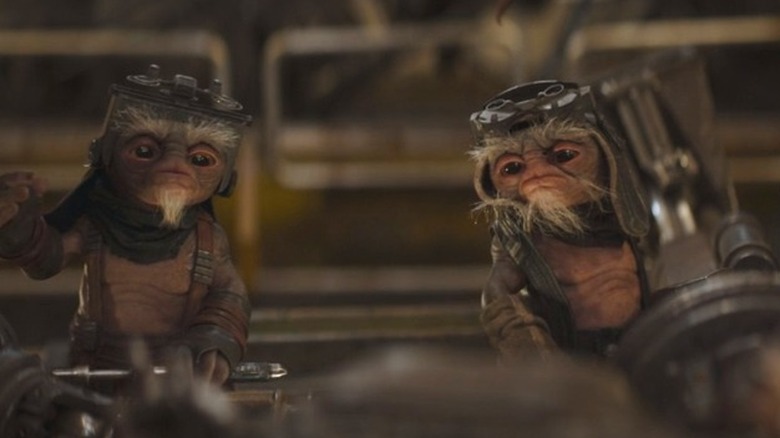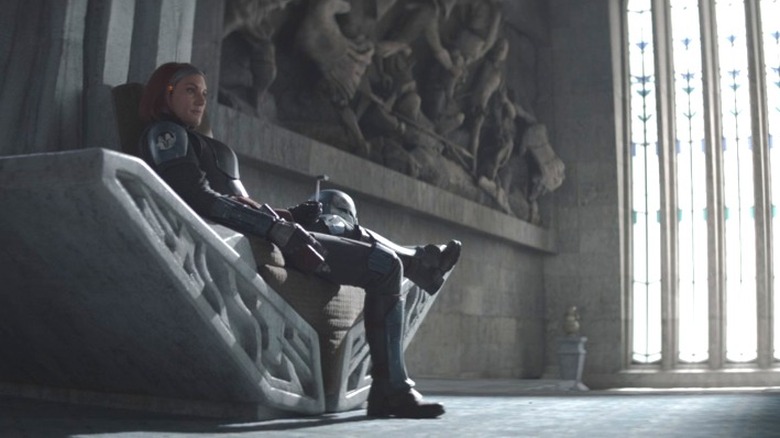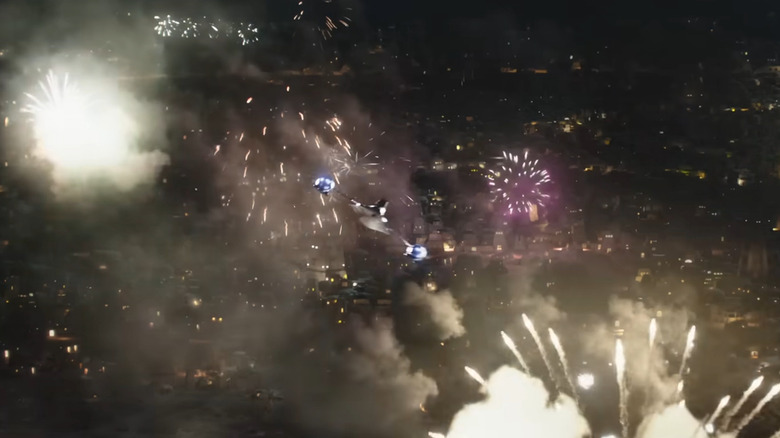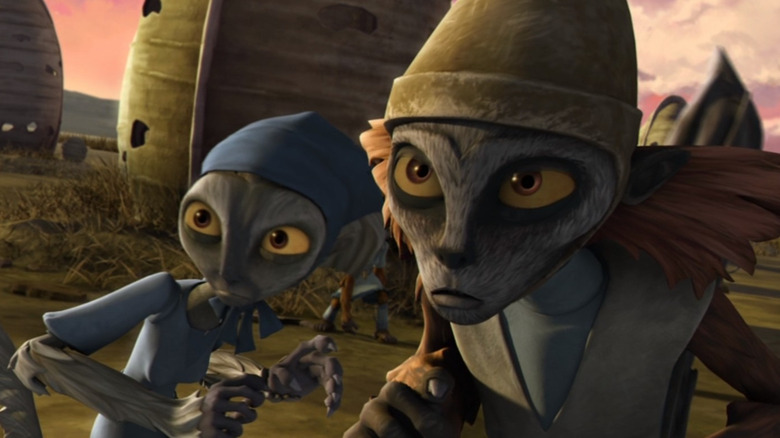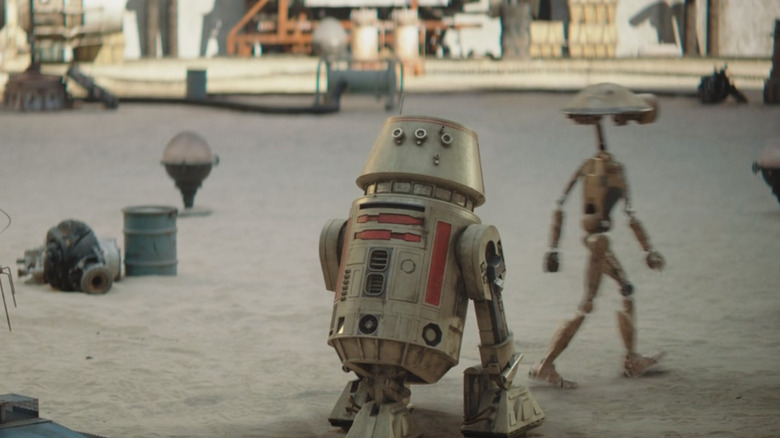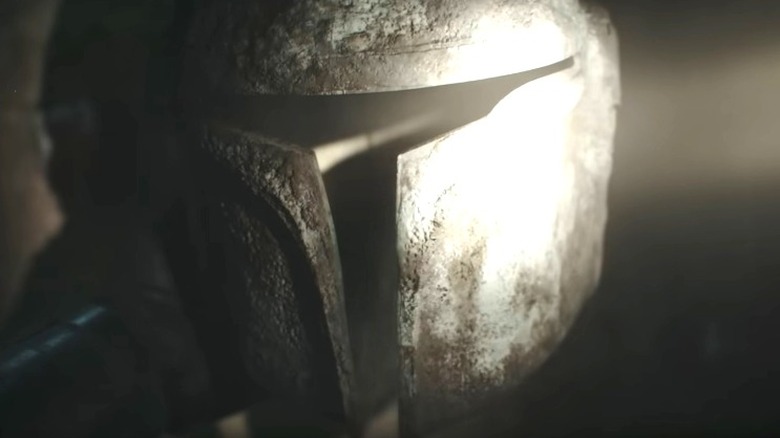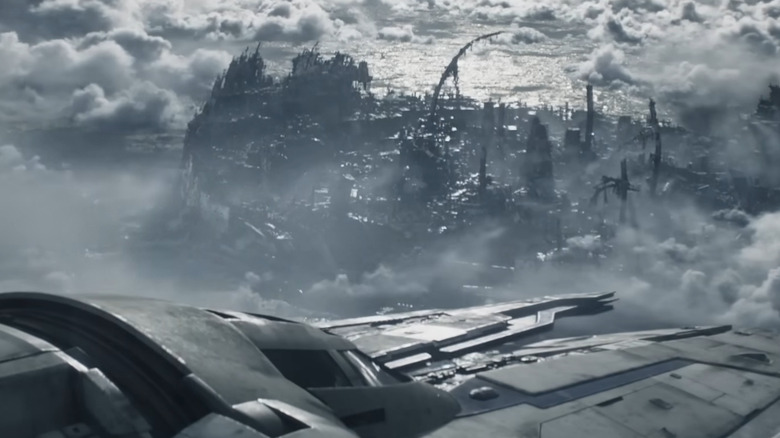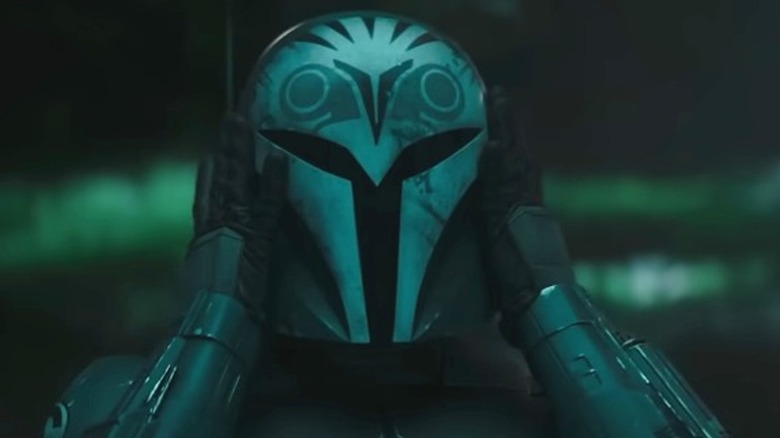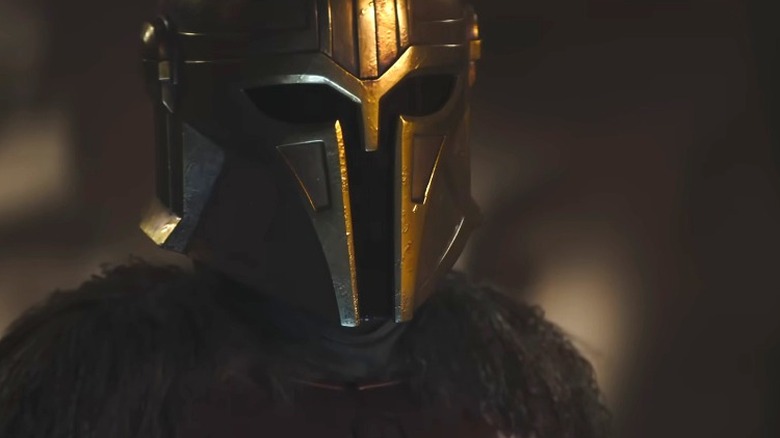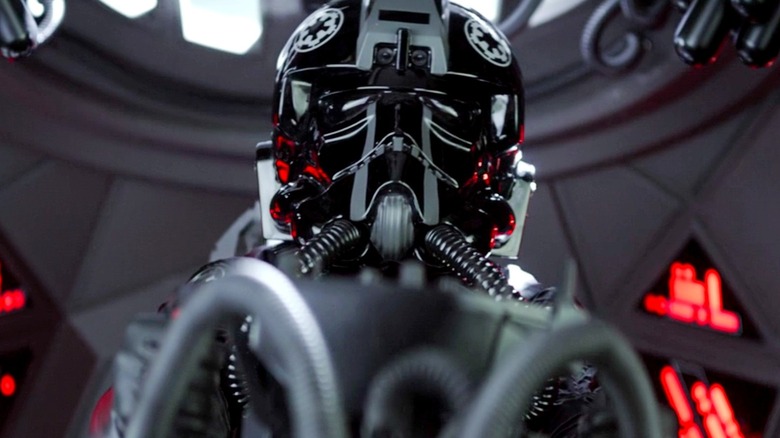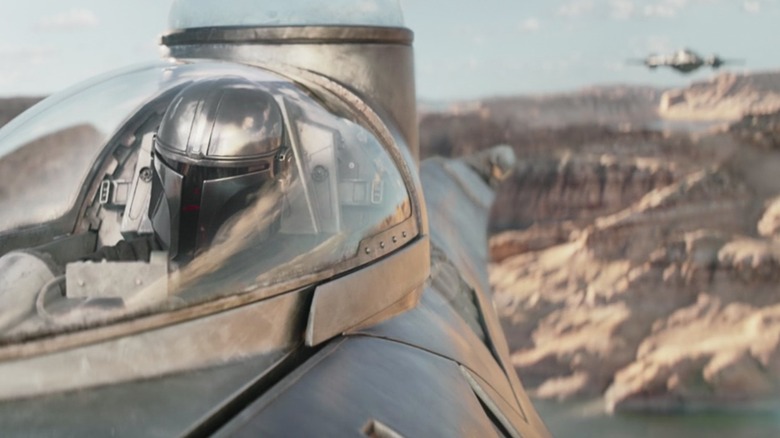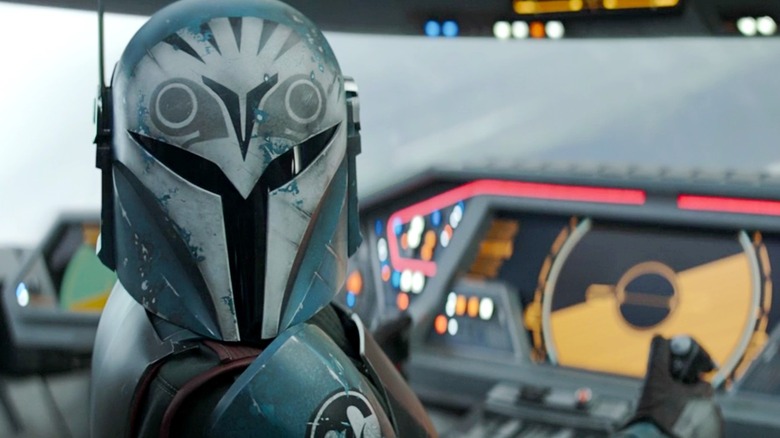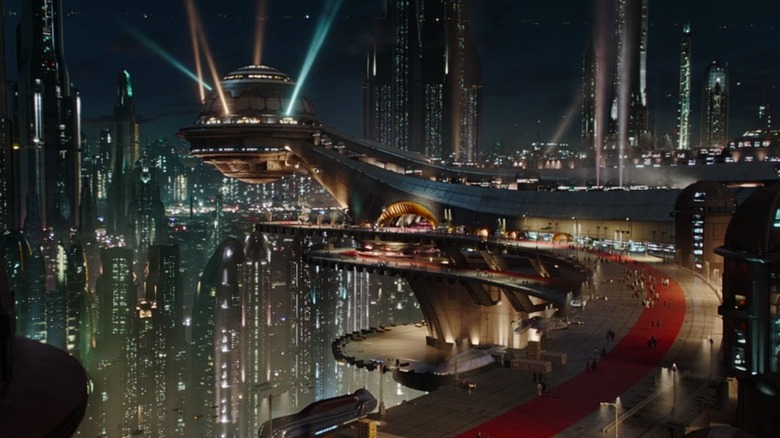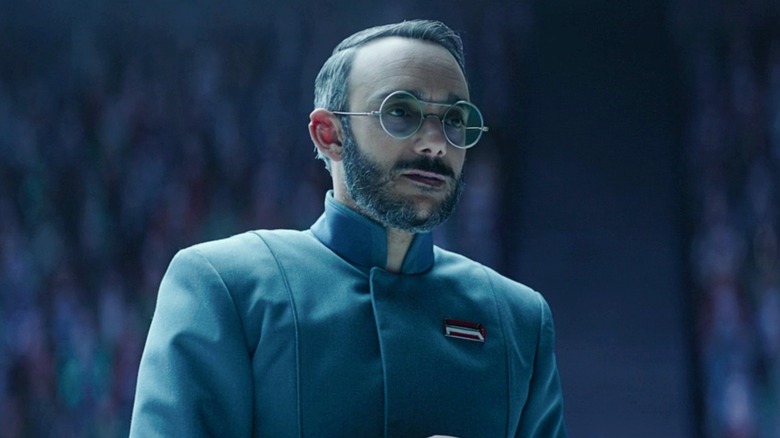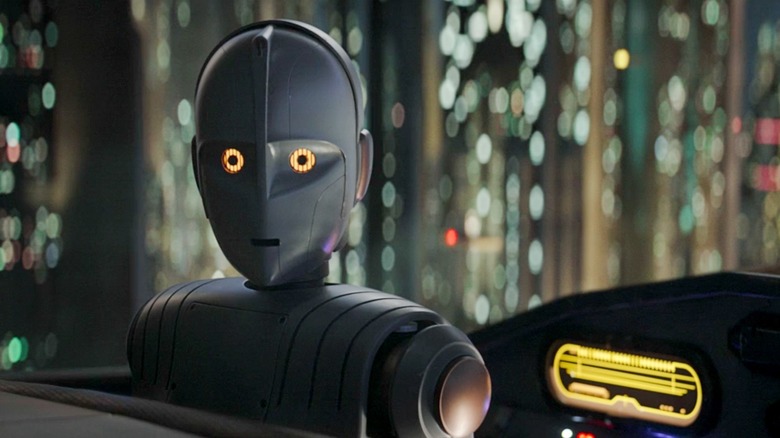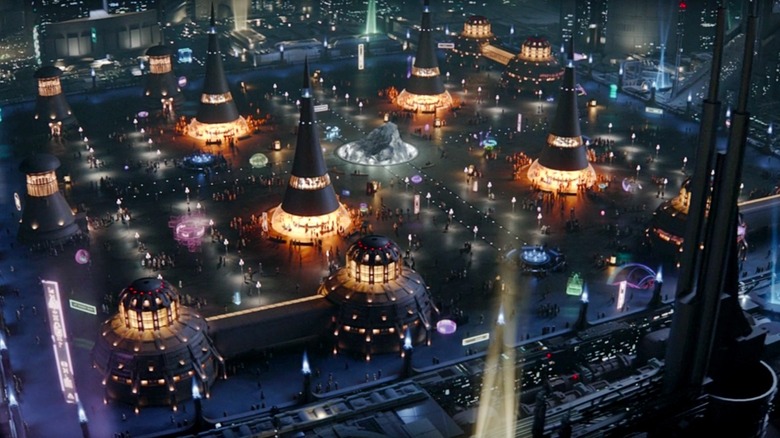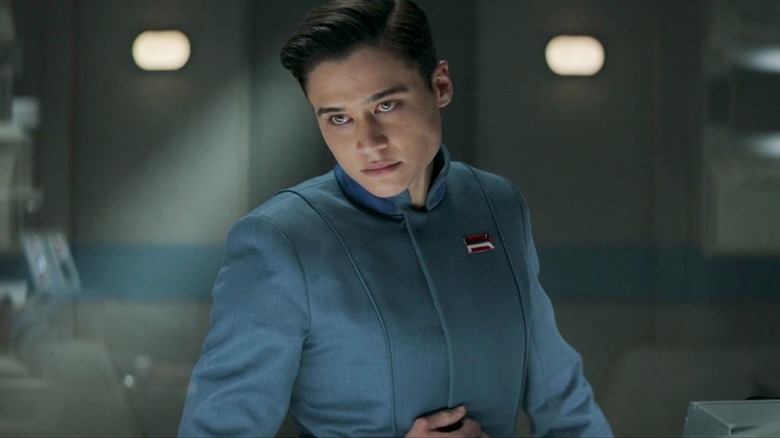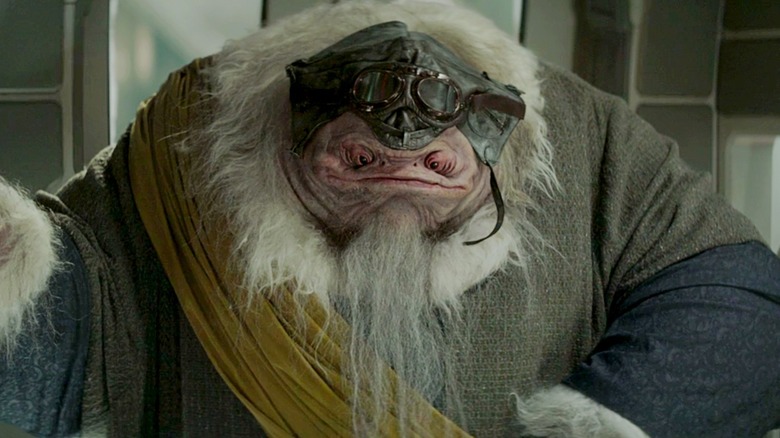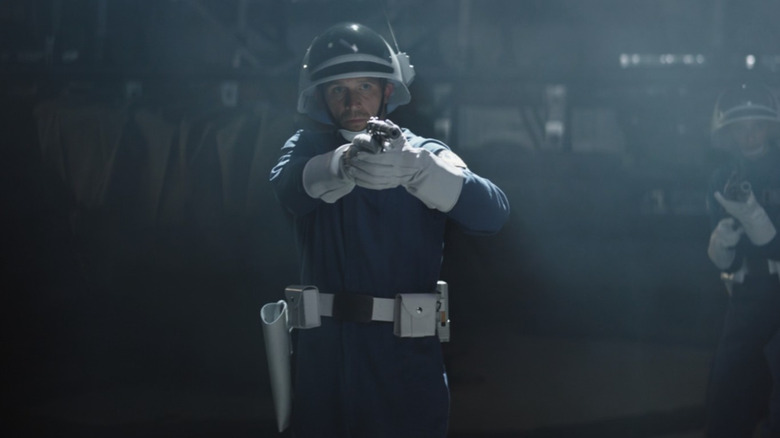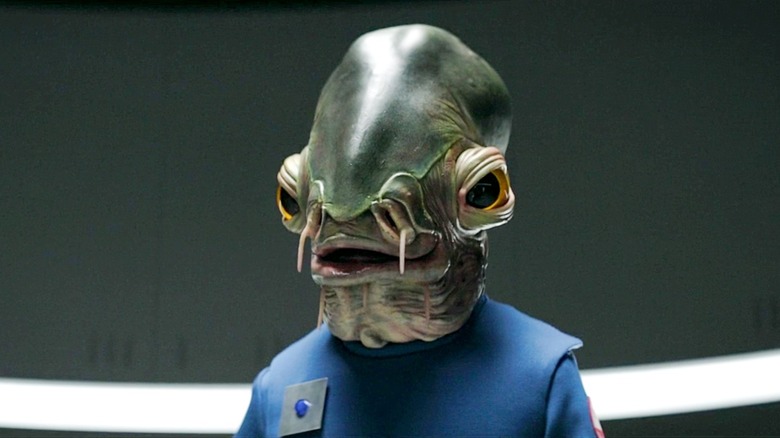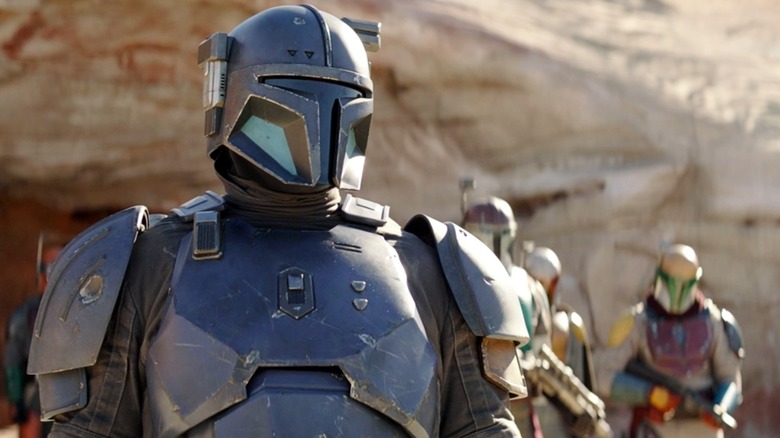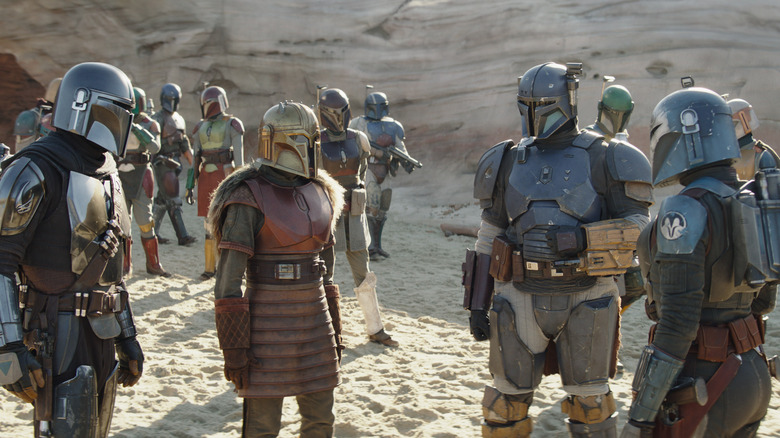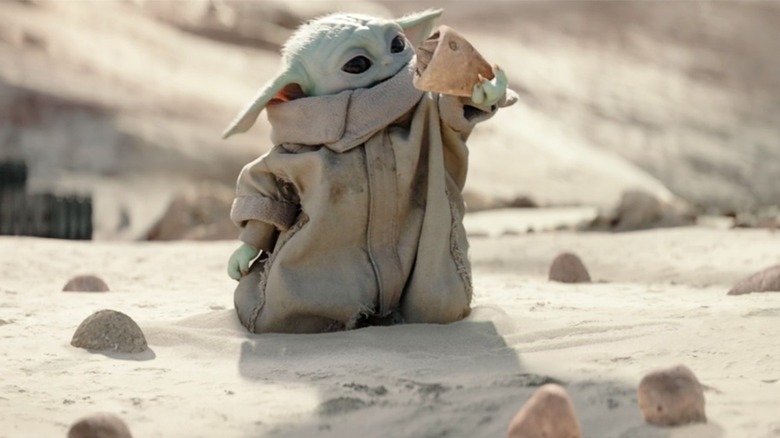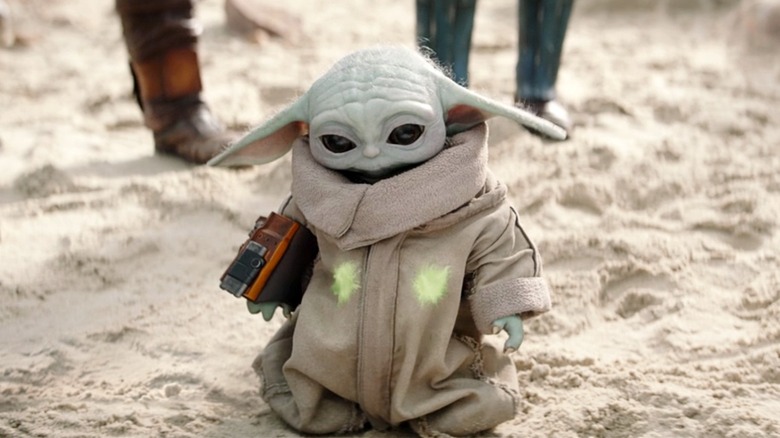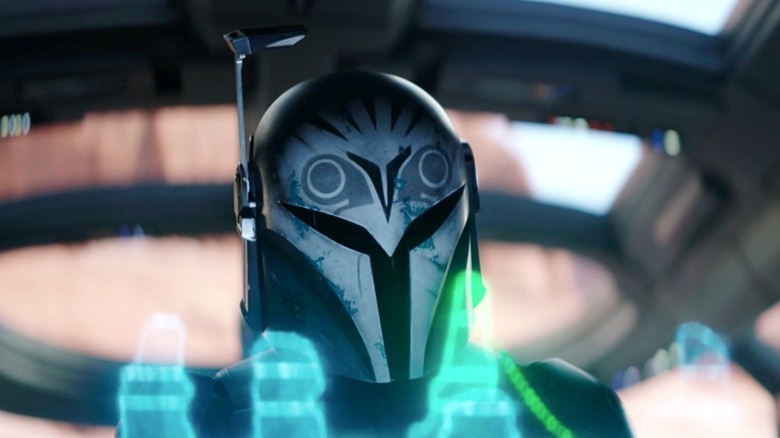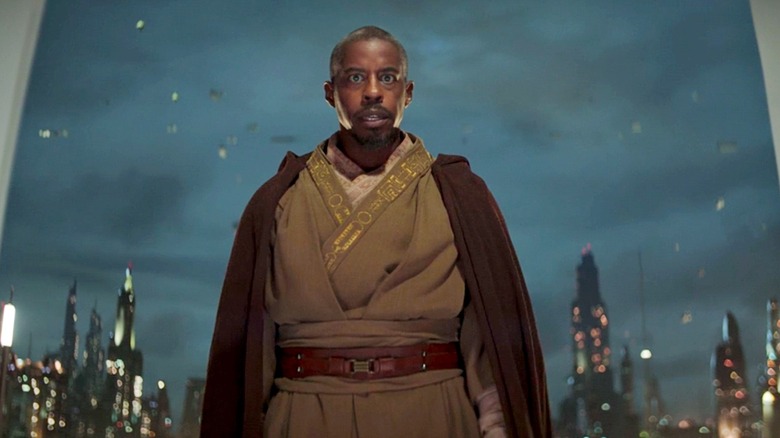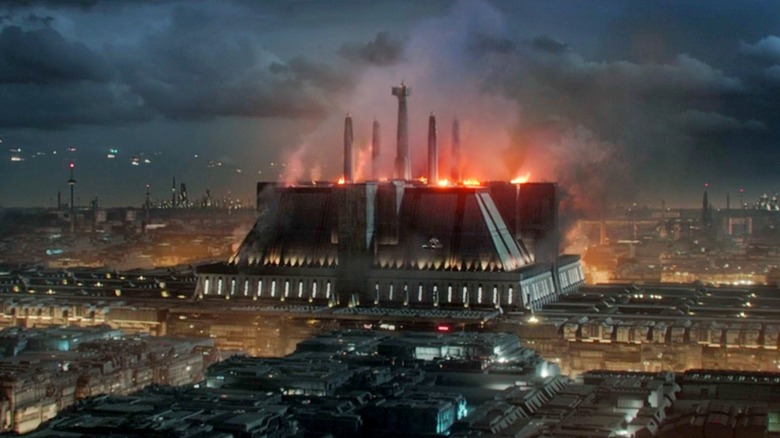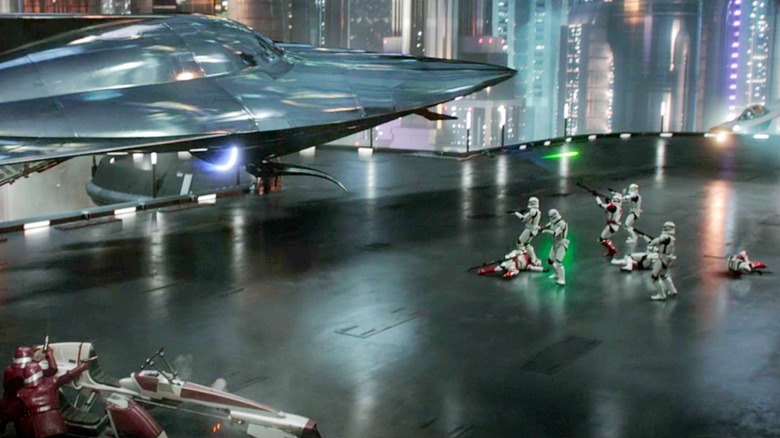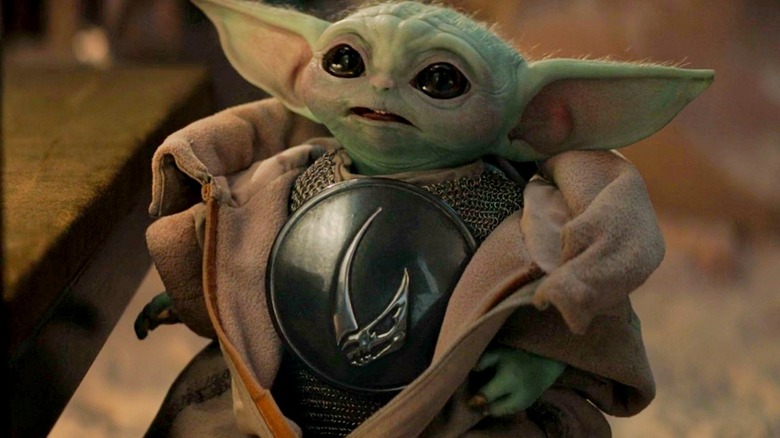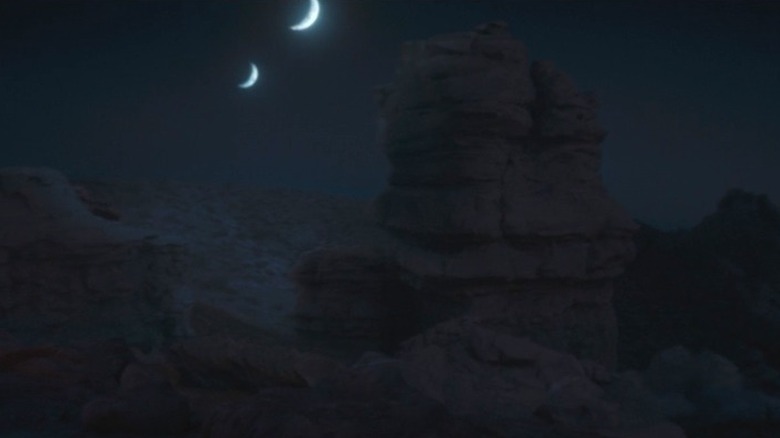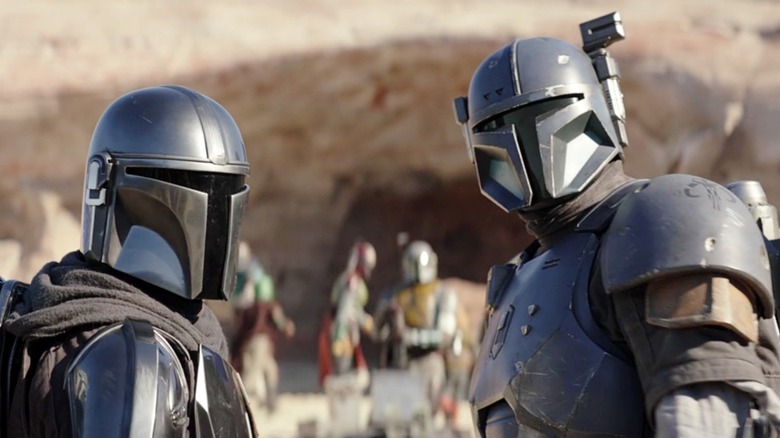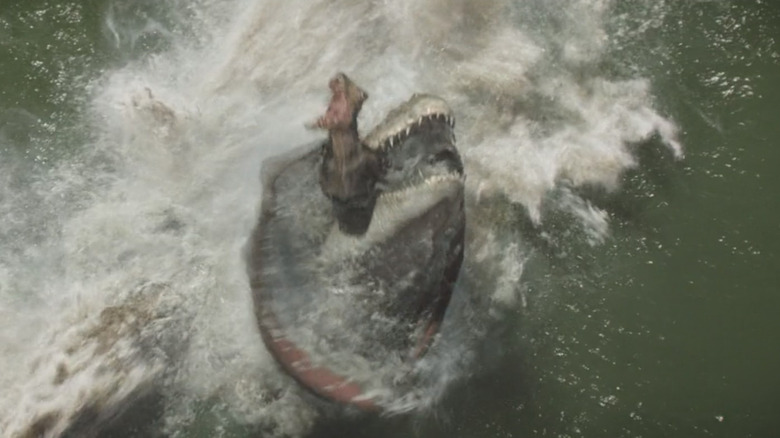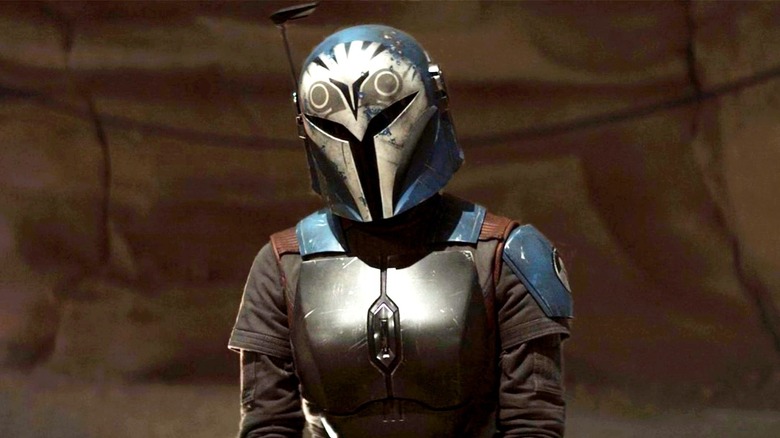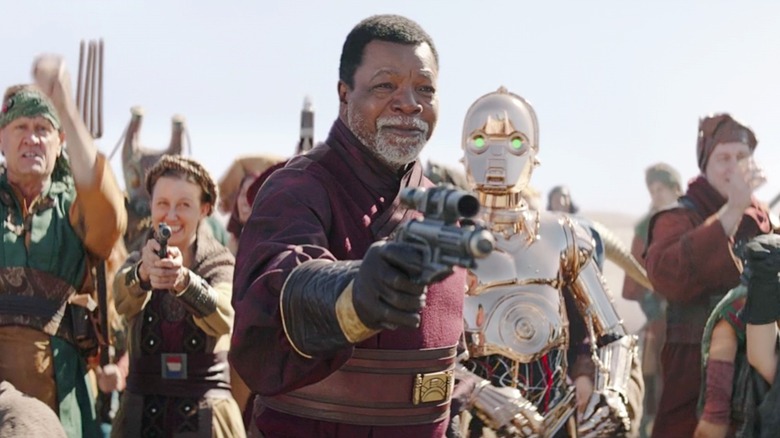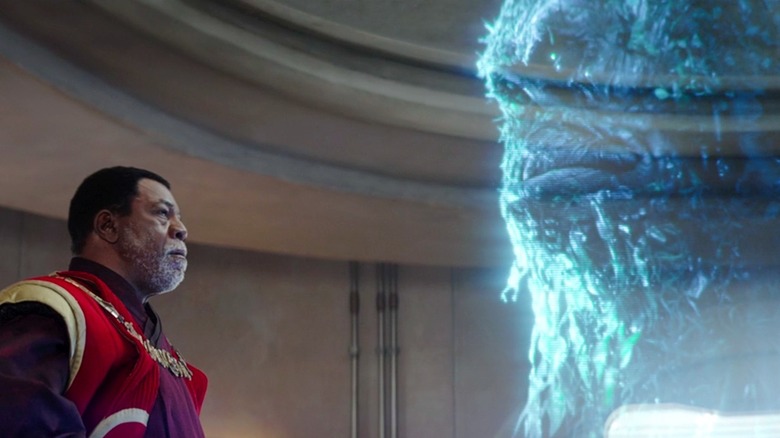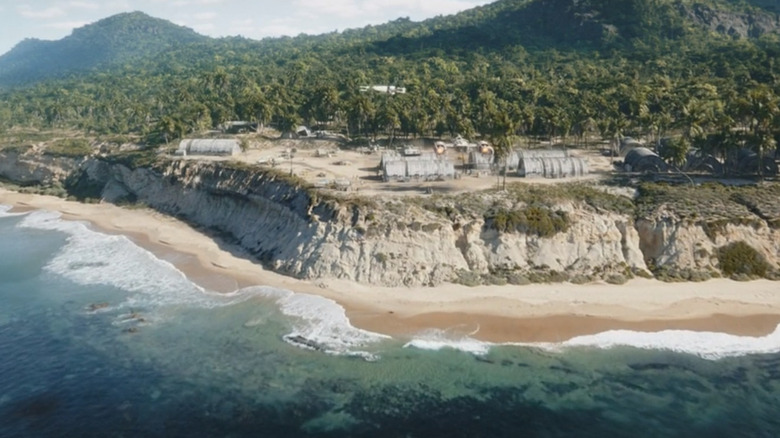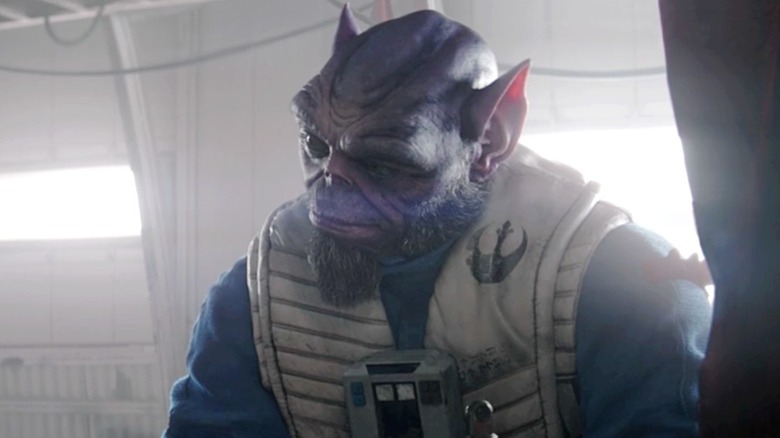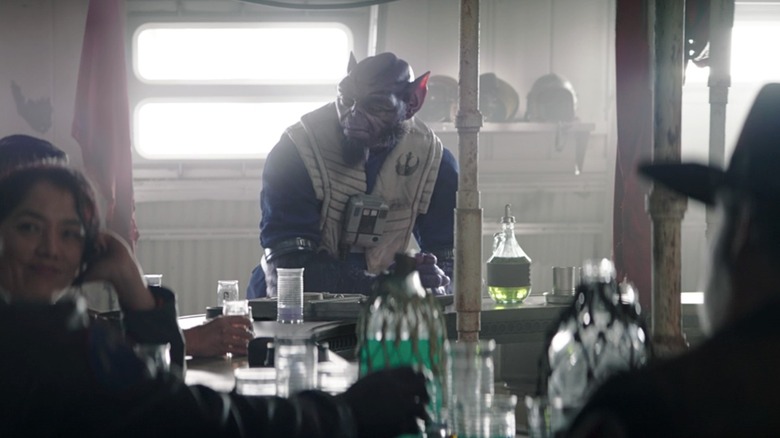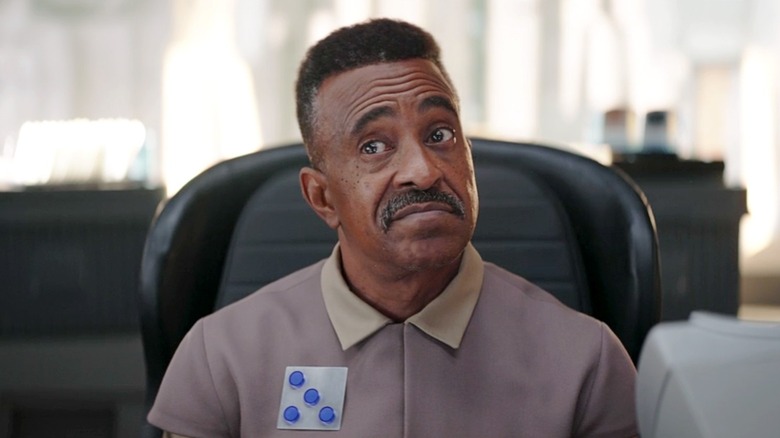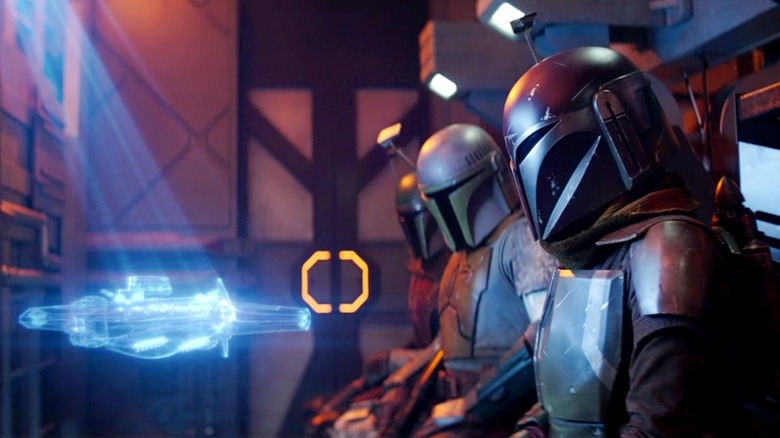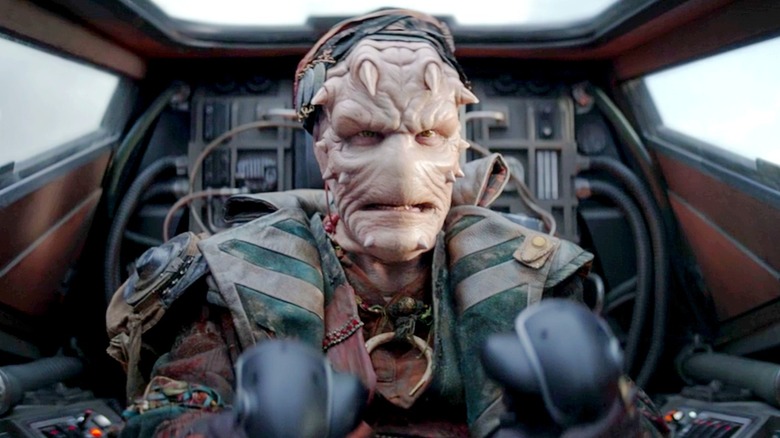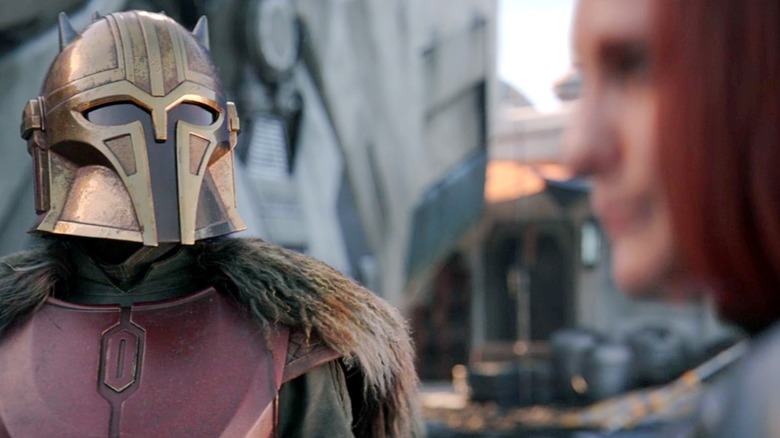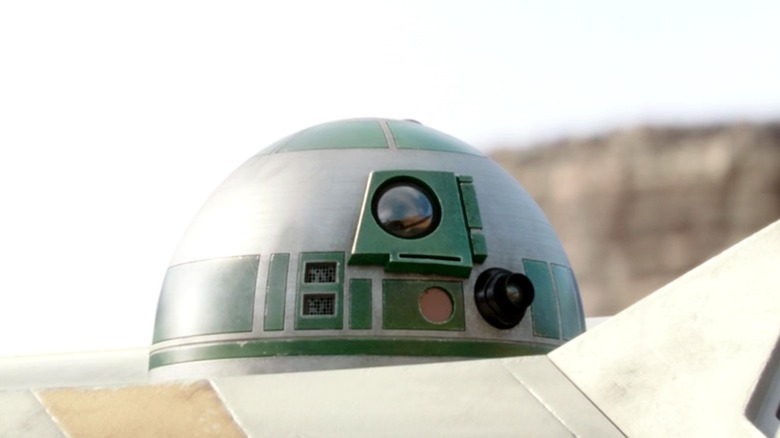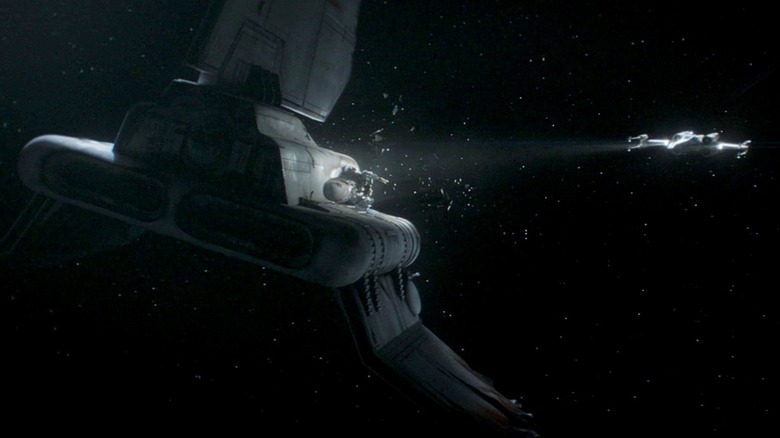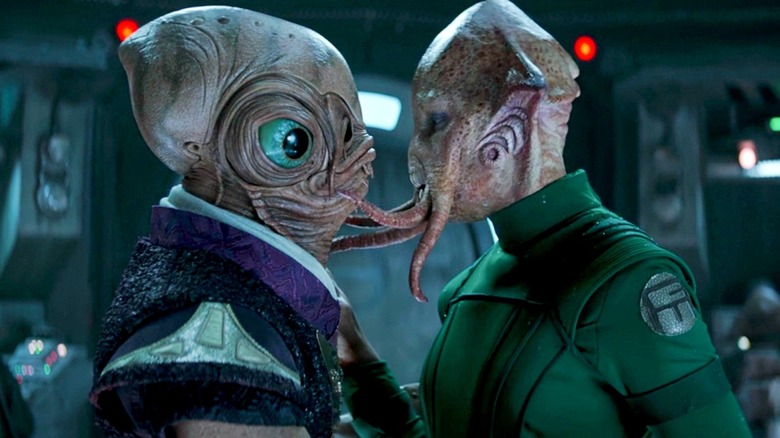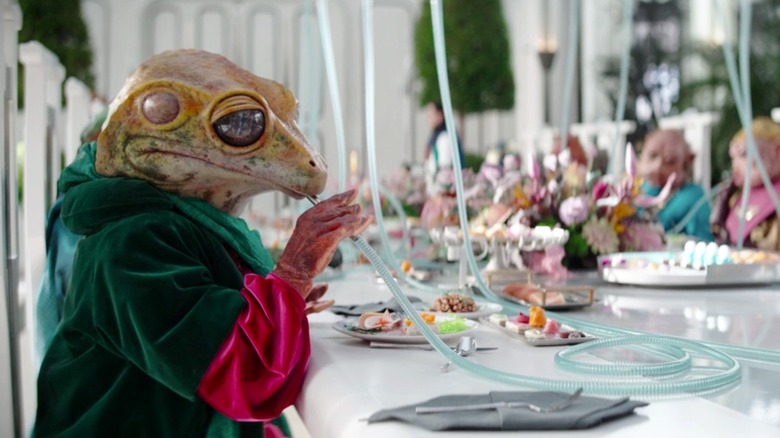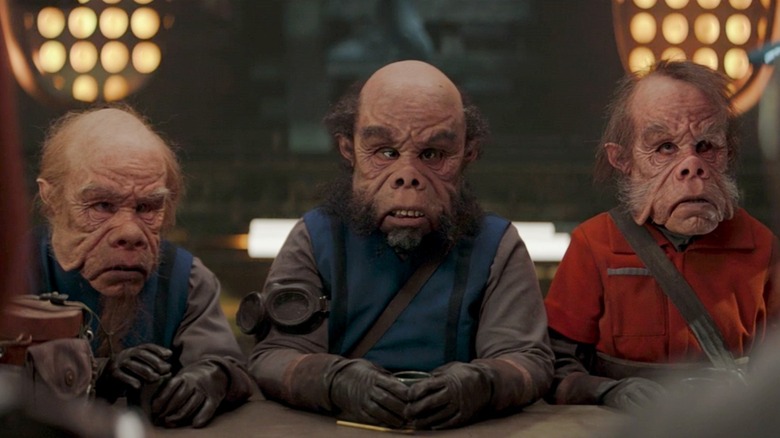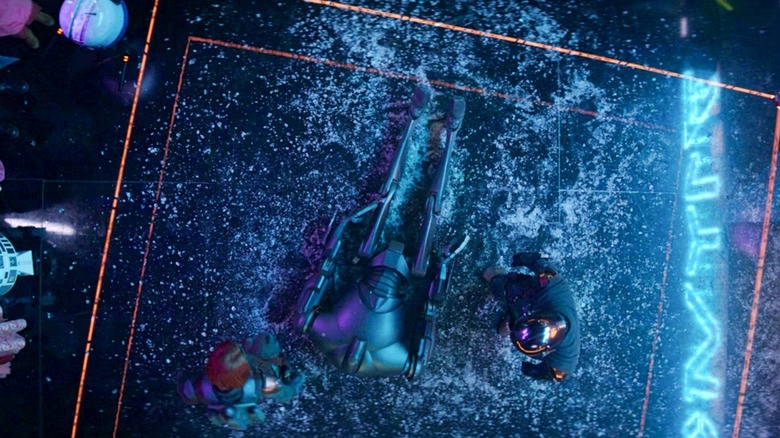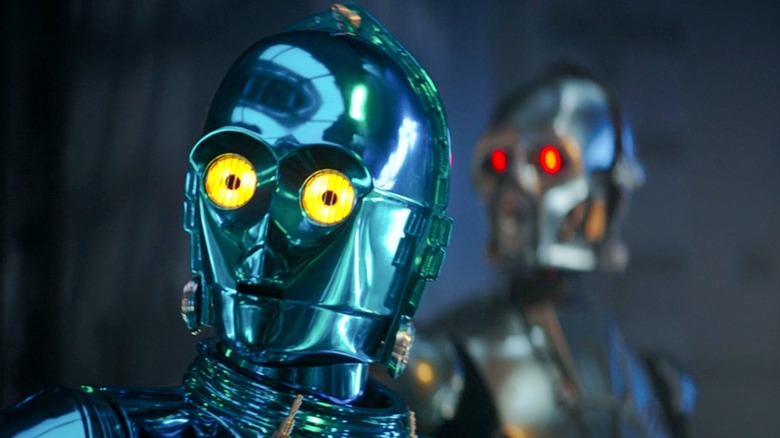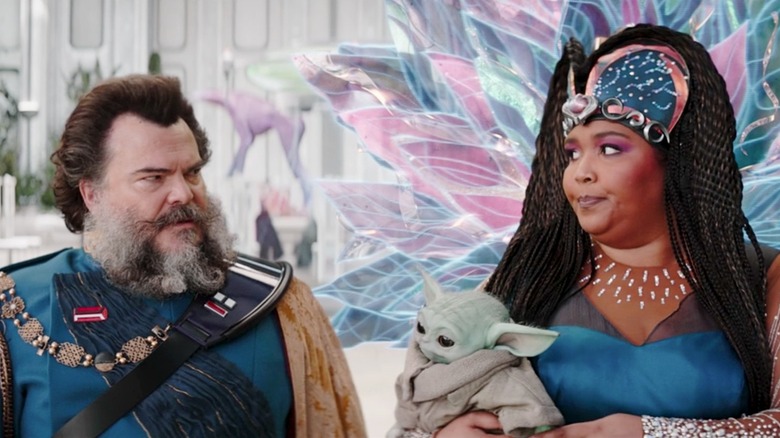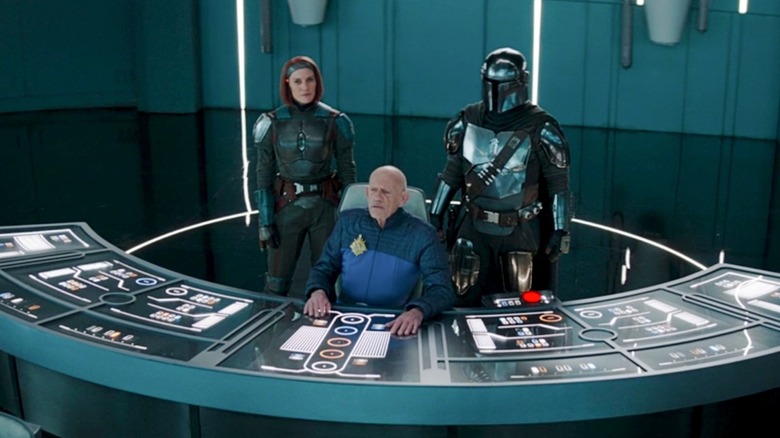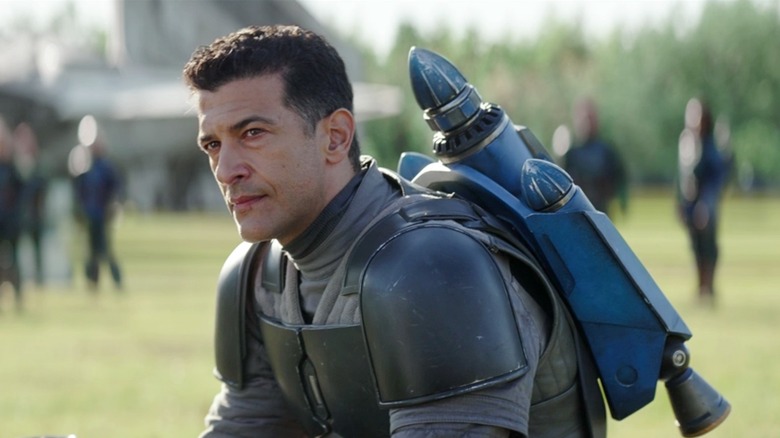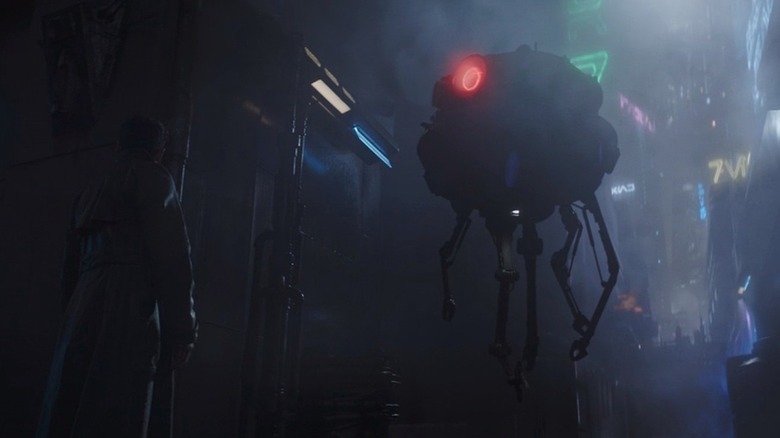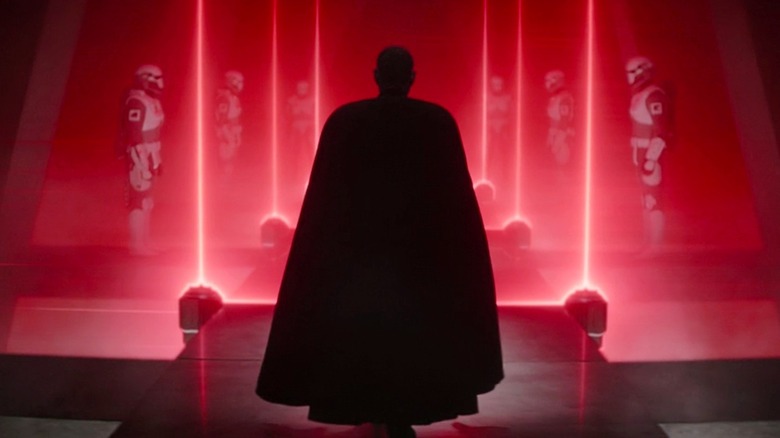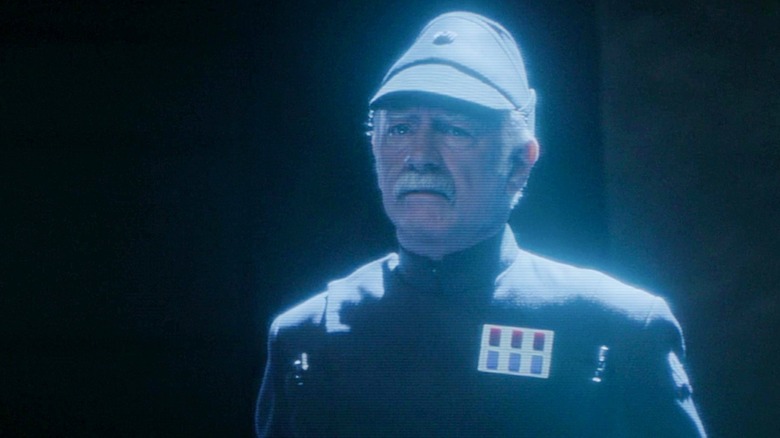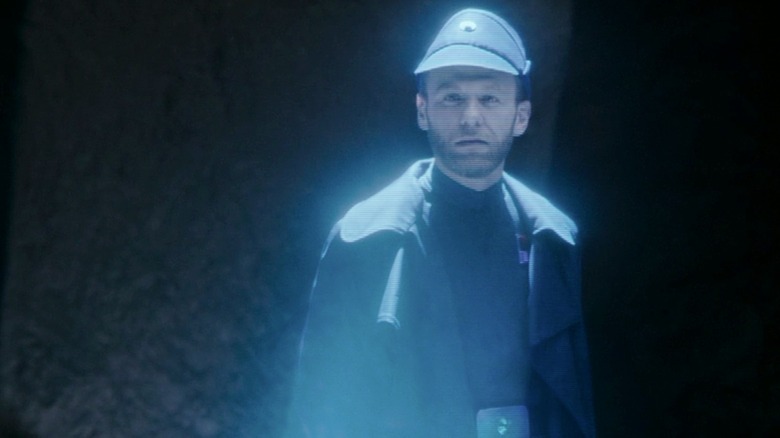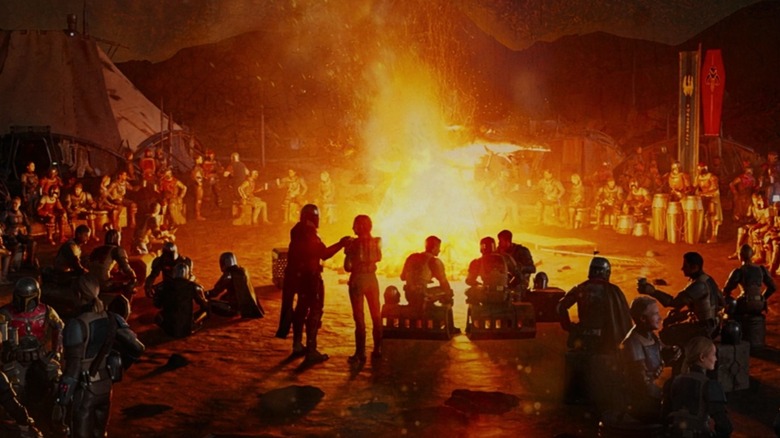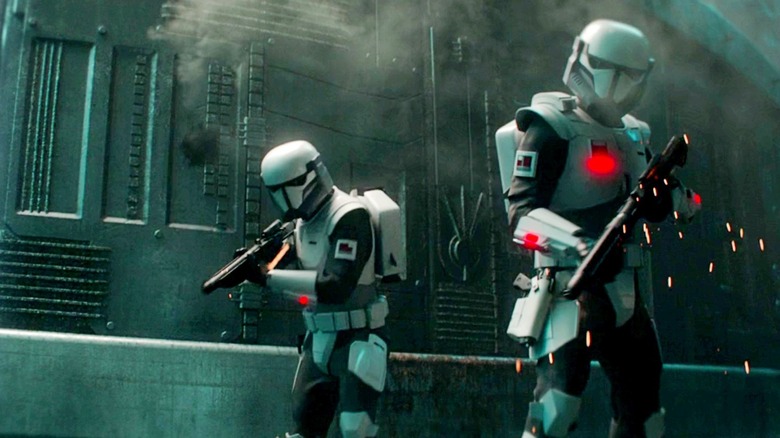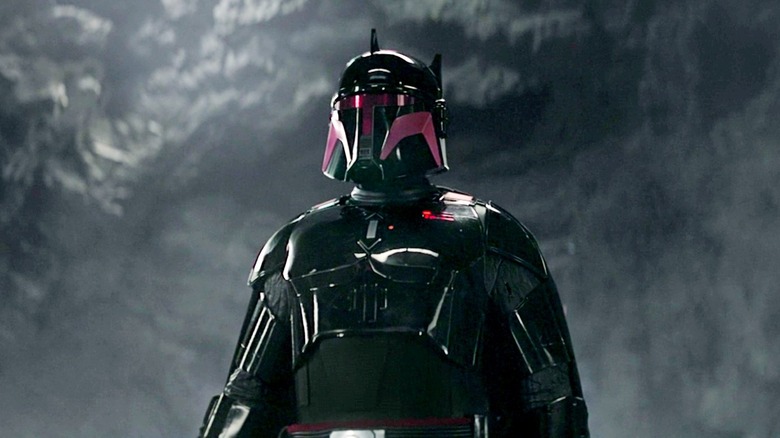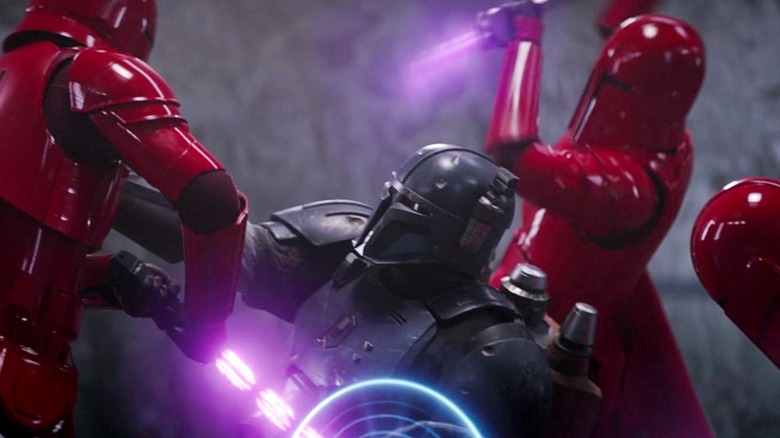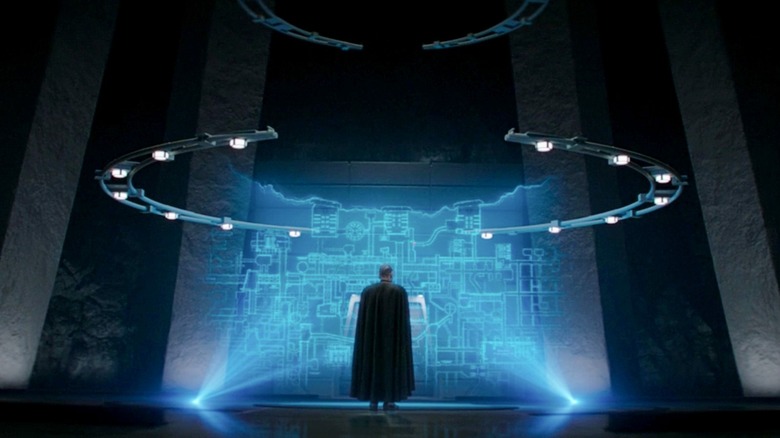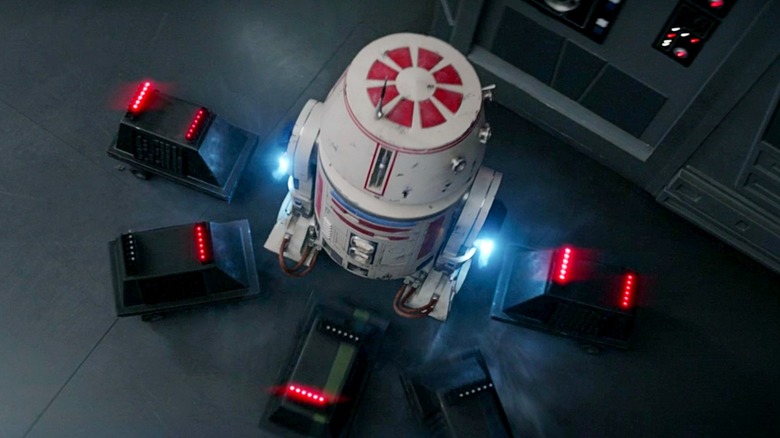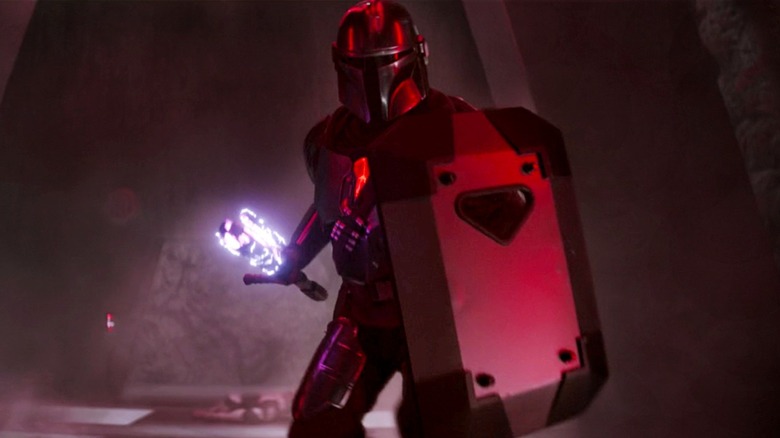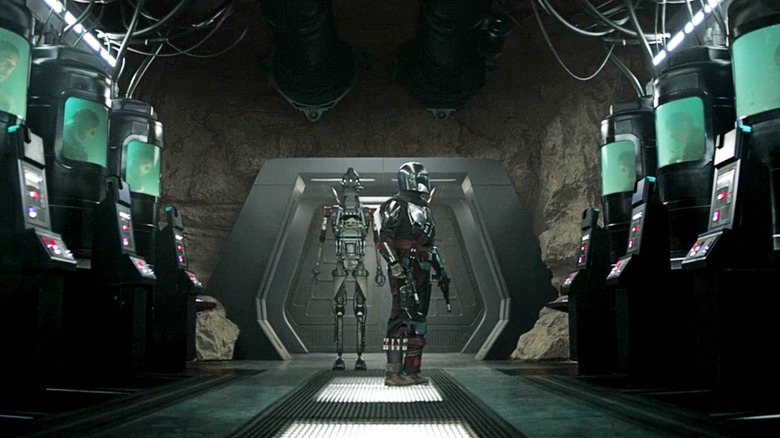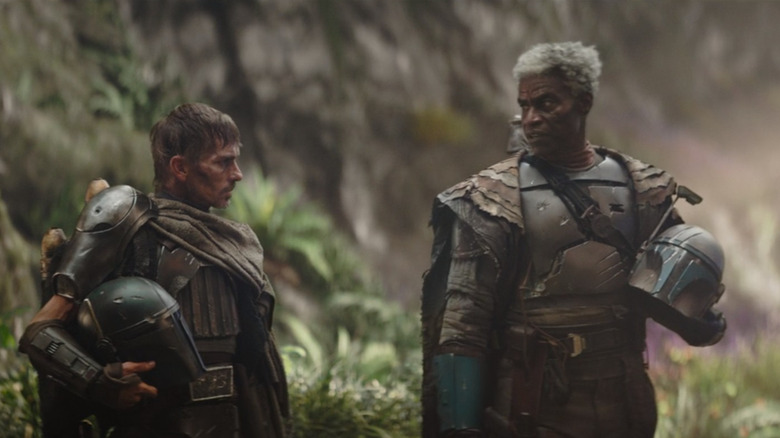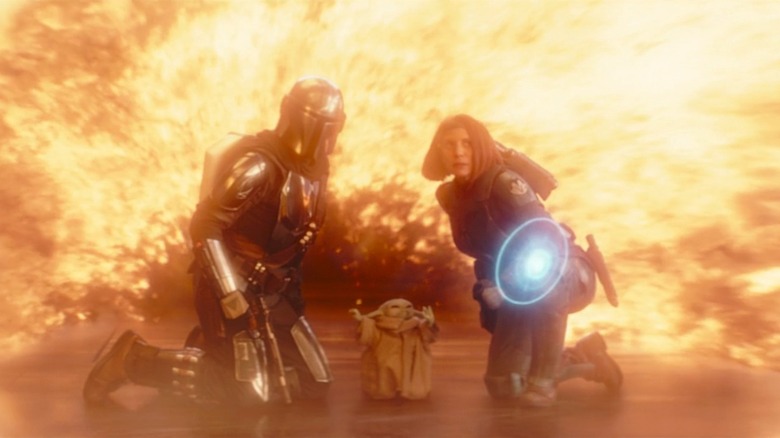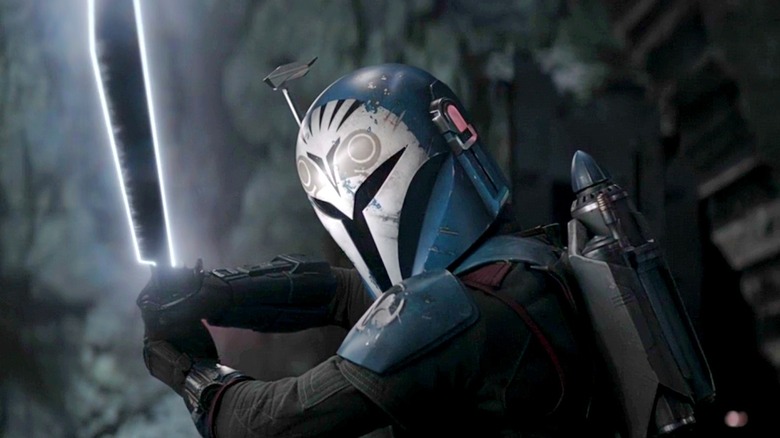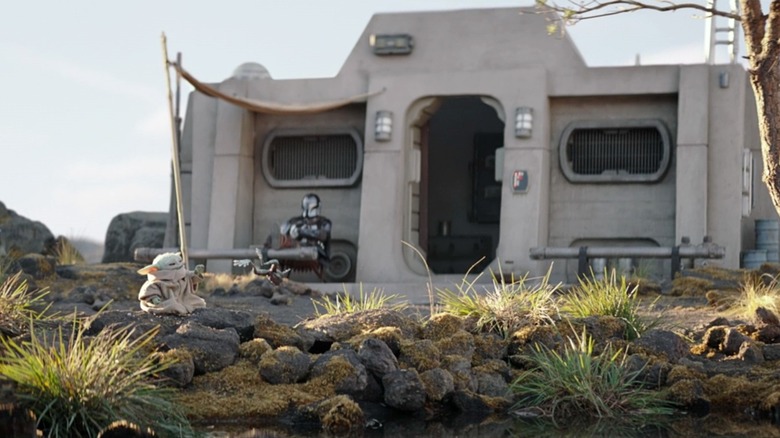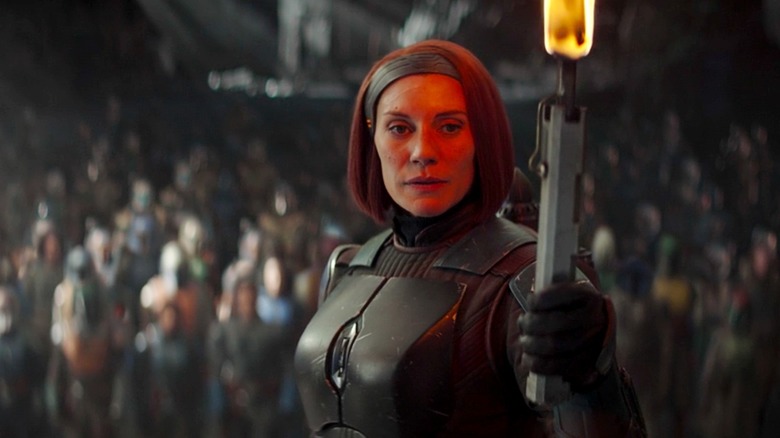Easter Eggs You Missed In The Mandalorian Season 3
The lone gunslinger and the child he must protect — it's a tale as old as time, and the story of "The Mandalorian," which is still going strong in Season 3, though things look a little different now than when the show first started back in 2019. A multi-year break after Season 2 left the fates of Din Djarin (Pedro Pascal) and Grogu (formerly Baby Yoda) up in the air, though their story continued briefly in the Disney+ spin-off series, "The Book of Boba Fett." Now, though, they're finally back for real.
At the start of Season 3, Din has one objective: redeem himself in the eyes of his people after breaking their code to show Grogu his true face. To do that, he has to return to Mandalore and bathe in the "living waters" beneath the planet's old beskar mines. And to that, he has to complete some side quests. Yes, it's still "The Mandalorian." Between all the planet-of-the-week adventures and big-picture "Star Wars" storylines, the series still gets to squeeze in plenty of little wink-and-nod moments for diehard fans of the franchise. Here are some Easter eggs you might have missed in "The Mandalorian" Season 3.
Mandalorian clan flags
The opening scene of "The Mandalorian" Season 3 shows a coming-of-age ceremony held by Din's old group — the Children of the Watch (meaning Death Watch), as Bo-Katan (Katee Sackhoff) calls them. The Armorer (Emily Swallow) crafts a small helmet for a newly christened member and conducts a sort of baptism. Many others have gathered for the occasion, and they seem to have brought their standards with them to show off their clan sigils.
It's not explicit that the flags held at the ceremony represent different clans or houses, but it seems like the only logical explanation. The idea of Mandalorian clans has long been a key facet of their lore in the "Star Wars" universe, and in "The Clone Wars," it's shown that Death Watch in particular always had a lot of reverence for this old hierarchy. The great factions on Mandalore were known as houses — Vizsla, for instance, represented in this scene by Paz Vizsla, or Kryze. The smaller families who served those great names were known as clans — for instance, Wren.
At the ceremony, we see the Mandalorians organized around flags of various colors and symbols, likely signifying these inner subdivisions. It's also worth noting that the Armorer walks out flanked by two particularly recognizable symbols — the mythosaur skull that's come to represent all Mandalorians of this faction, and what appears to be a variant of Boba Fett's wheat stalk crest.
N1 nostalgia
In the time since "The Book of Boba Fett," Din Djarin seems to have become much more comfortable flying his new starfighter. The rebuilt N1 — famous for being the baseline ship of the Naboo royal fleet — is loaded with nifty gadgets and add-ons, but it also comes packed with plenty of winks and nods to its debut appearance in "The Phantom Menace."
When Din swoops in to save the Mandalorians from the giant monster in Season 3, Episode 1, he kills the beast with proton torpedoes. These iconic weapons go all the way back to the original Death Star run, of course, but they're also used by Anakin to destroy the Trade Federation's droid control ship in "The Phantom Menace." Brief shots of the ship's interior reveal the same sleek controls and readouts seen in the prior film, as first shown in "The Book of Boba Fett." And of course, when Din is attacked by pirates later in the same episode, he evades them by spinning. Hey, that's a good trick.
Glimpses of the Purrgil
One of the more ethereal moments in "The Mandalorian" Season 3, Episode 1, "The Apostate," comes during a hyperspace voyage. From his bubble cockpit in the new N1, Grogu has a 360-degree view of hyperspace as he and his dad travel through it, and on their way to Nevarro, Grogu notices some looming, shadowy shapes just out of focus beyond the ship. If you've seen "Star Wars Rebels," you'll recognize these strange figures instantly.
Known as the Purrgil, these giant space whales are able to travel through hyperspace naturally. Legends shared by Hera Syndulla in "Rebels" suggest that other species first developed hyperspace travel in an effort to emulate the Purrgil's abilities. We also know from "Rebels" that the creatures can be connected via the Force, as Ezra Bridger demonstrates on several occasions. Perhaps that's why Grogu is able to sense them so profoundly.
While the Purrgil aren't directly discussed in "The Apostate," their appearance seems like a clear setup for later in the season, or for the upcoming "Ahsoka" series. During her cameo appearance in "The Mandalorian" Season 2, Ahsoka (Rosario Dawson) reveals that she's hunting Grand Admiral Thrawn, who was last seen whisked away by Ezra's Purrgil in the "Rebels" finale. And since Eman Esfandi has already been cast to play Ezra in the upcoming series, it's safe to assume the Purrgil will return. You have to admit, they look a good bit cooler outside of cartoon land.
Familiar faces on Nevarro
Under the rule of High Magistrate Greef Karga (Carl Weathers), the once-backwater planet of Nevarro has transformed into a thriving trade hub. The automated message that plays as Din lands calls it "the gem of the Outer Rim," and Greef says that it's becoming a major stop along the heavily-traveled Hydian Way. That might explain why there are so many different sorts of aliens and droids on the planet now, many of which should look familiar to "Star Wars" fans.
There are Mon Calamari, Quarren, and even a cook droid of the same basic style seen in "Attack of the Clones." There are also a few familiar faces from Jabba the Hutt's Tatooine palace — an EV-series supervisor droid, and a whole tree filled with Kowakian monkeys. Of course, the esteemed Salacious B. Crumb himself, Jabba's Kowakian pet, is nowhere to be found, since he died along with Jabba in "Return of the Jedi."
One face you might expect to see on Nevarro is mentioned only in name, however: Cara Dune, the former rebel shock trooper played by Gina Carano. Carano was famously fired from "The Mandalorian" after a series of tweets comparing being a Republican to the Holocaust, criticizing safe masking policies during the Covid-19 pandemic, and mocking the LGBTQ+ community. When Greef tells Din he needs a marshal, the Mandalorian asks what happened to Cara. Greef responds that she was recruited into the New Republic special forces after bringing in Moff Gideon (Giancarlo Esposito).
Weequay pirates
How can you tell that Dave Filoni had his hands on a "Star Wars" project? Looking for Weequay pirates is a good start. A group of the infamous racketeers shows up on Nevarro in "The Apostate" and immediately starts causing trouble. To be fair, not every pirate in the gang is Weequay — the spiky-headed race most famous for giving us the inexplicable Hondo Ohnaka in "Clone Wars" and "Rebels." Other races are represented as well, including what appears to be a new live-action Trandoshan design. Din Djarin and Greef Karga do away with the crooks easily enough (with Greef sporting a blaster eerily reminiscent of Han Solo's), but that's not the end of them.
The encounter runs Din afoul of Gorian Shand, a self-proclaimed "Pirate King" who later battles the Mandalorian in space. Shand himself is not Weequay, and seems like a sad substitute for good ol' Hondo, but he does bear a strange resemblance to Davy Jones of "Pirates of the Caribbean" fame. The alien's green mess of mossy ... hair? Tentacles? Seems like a direct reference to the fantasy film franchise, which of course, is also owned by Disney. Avast, here there be questionable franchise crossover opportunities!
The (asset) Terminator
In order to complete his mission of redemption and journey back to Mandalore, Din decides that he needs a droid. He fears that the planet may still be "poisoned," after all. Unfortunately, Din's traumatic childhood during the Clone Wars has left him with some major droid trust issues. The only one he wants to work with is IG-11, who, inconveniently, is dead. In trying to repair the droid, Din accidentally triggers IG-11's old programming, prompting him to lash out and attack Grogu. Of course, the droid doesn't have any legs, so he has to crawl slowly across the floor.
This seems like a direct reference to the end of "The Terminator," in which the titular mechanoid assassin continues its pursuit after having its legs blown off. IG-11 even states his intent to "terminate asset," meaning Grogu. Surely, that's not a coincidental choice of words. To top it all off, IG's crawling is animated in a way that almost looks like stop-motion — the technique used for the T-800 in the original "Terminator." It still looks better than that uncanny valley Luke Skywalker in "The Book of Boba Fett," though.
Anzellan droidsmiths
When it becomes clear to Din that he can't fix IG-11 on his own, he takes him to the experts — Anzellan droidsmiths. That's right, the same species and profession as "The Rise of Skywalker" breakout star, Babu Frik (Shirley Henderson). While Babu himself doesn't appear to be present, the Anzellans we do meet have the same charm and no-nonsense attitude.
Babu has become quite the fan favorite since his debut in the 2019 film, possibly because of the dearth of other likable things in it. It's fun to see the Anzellans return, and also to learn that the whole race is thought of as the best droidsmiths in the galaxy. Is this a culturalized tradition? Or are Anzellans just naturally gifted at working with sentient machines? These great mysteries of Babu Frik's people remain, but with luck, we'll get our much-needed Anzellan spinoff series soon. One can only dream.
Shadows of Bo-Katan's past
At the end of Season 3, Episode 1, Din and Grogu travel to Kalevala to meet with Bo-Katan Kryze. He asks to join her mission to retake Mandalore, but she responds that the faction she built abandoned her after she failed to win the Darksaber. Since Din is the one who now holds the weapon, she clearly resents him, but she seems to resent her people's superstitious ways even more. "Wave that thing around," she says with clear disgust, "and they'll do whatever you say."
It's hard not to take this line as a reference to Mandalore's tragic history. Bo-Katan's own sister, Duchess Satine Kryze, was killed by the Darksaber when it was wielded by Darth Maul during the Clone Wars. A faction of Mandalorians followed Maul afterward simply because he had won the blade in combat, allowing him to rule the planet from the shadows. Bo-Katan helped Ahsoka Tano and her Republic forces oust the villain in "The Clone Wars" Season 7, but that didn't end her or the planet's troubles.
"Your cult gave up on Mandalore long before the Purge," Bo-Katan tells Din. "The Children of the Watch and all the factions that came before fractured and shattered our people." This statement might sound harsh, but if you've watched "The Clone Wars" and "Rebels," you know Bo-Katan's pain. She watched her planet be torn apart by radicals, terrorists, Separatists, clones, and Imperial occupiers before finally seeing it burned to nothing. Sitting on the throne her sister must have sat on decades prior, Bo-Katan looks like she's finally fed up with it all. But she still sends Din back to Sundari, the old capital where Satine used to rule.
Boonta Week
You might think Tatooine's barren landscape wouldn't generate much festive energy, but that's far from the truth. In addition to general cantina hangin' and the thrill of frequent shootouts, the desert planet has at least one major holiday: Boonta Eve. When Din Djarin visits mechanic Peli Motto (Amy Sedaris) in Season 3, Episode 2, the holiday is nigh, and viewers see her complaining to a client (as part of a scam, to be fair) about having to work Boonta Eve.
This isn't the first time the holiday is mentioned in "Star Wars" canon. The podracing event won by Anakin in "The Phantom Menace" is called the Boonta Eve Classic, so it has long been known as a big day for denizens of Tatooine. According to some "Star Wars" encyclopedias and sourcebooks, the holiday celebrates a Hutt named Boonta who supposedly achieved godhood. According to Peli, it's mostly an excuse for drinking and carousing in the cantinas.
"The Mandalorian" does add some interesting details to the lore of Boonta Eve, though. Anakin lives in Mos Espa during his childhood, but viewers see through Peli that Mos Eisley also takes the holiday very seriously. There are fireworks when Din and Grogu leave, and Peli alludes to an entire Boonta Week of celebration.
Leaping like a Lurmen
When Din Djarin and Grogu reunite with Peli Motto in "The Mines of Mandalore," Grogu is so happy he literally jumps for joy. The Force flip he does is a nice little nod to Yoda's own dexterous fighting style, and Peli responds with a deep-cut reference. "Who taught you how to leap like a Lurmen?" she asks, conjuring one of the franchise's more obscure, offbeat species.
The Lurmen are small, lemur-like creatures native to the planet Mygeeto and debuted in a Season 1 episode of "Star Wars: The Clone Wars." As the title suggests, the episode "Jedi Crash" sees three Jedi — Anakin Skywalker, Ahsoka Tano, and Aayla Secura — crash on the planet Maridun. Anakin is severely injured, so Ahsoka and Aayla enlist help from a group of local Lurmens. Led by the strict pacifist Tee Watt Kaa, this faction departed their home system and colonized Maridun in an effort to escape the war. They mostly serve as a pacifist strawman against which the show levies some elementary-school-level philosophizing about violence and war. While certainly not a central species in the grand "Star Wars" mythos, "The Mandalorian" Season 3 shows that they haven't been forgotten.
R5-D4
Din Djarin gains a surprising new ally in Season 3 — astromech droid R5-D4. The droid first appeared in the series in Season 2, but he takes on a much more significant role in Season 3 as Din's official astromech companion. This is indeed the same R5-D4 who debuted in "A New Hope," and "The Mandalorian" adds some interesting details to his canonical story.
R5 is most famous for one thing — nearly becoming a primary droid in the series, but having a "bad motivator" when Luke Skywalker and Owen Lars were in the process of buying him from the Jawas. His poorly maintained machinery made him the Wally Pipp to R2-D2's Lou Gherig, and it was instead R2 who went on to help save the day and become a galactic hero. What you might not know is that R5 actually blew his motivator on purpose, to ensure R2's mission was a success.
In the canonical short story, "The Red One," by Rae Carson, featured in the collection, "From a Certain Point of View," it is revealed that R2 tried to sabotage R5 the night before the sale. R5 woke up and noticed the attack, prompting R2 to explain that the fate of the galaxy depended on him escaping the Jawas. In a selfless move, R5 agreed to sabotage himself. Peli Motto says that R5 actually went on to serve in the rebellion after his encounter with R2, which has been alluded to before. Unfortunately, few details exist on the droid's other courageous actions. Another of Peli's droids, BD-72, is of the same BD design as "Star Wars Jedi: Fallen Order" character BD-1.
Concordia
After two full seasons and some bonus adventures, Din Djarin and Grogu finally journey to Mandalore in Season 3, Episode 2. There's a nice scene before they land that has Din pointing out various features of the system, including the moon where he himself grew up: Concordia. While the two don't actually go there in the episode, "Star Wars: The Clone Wars" visits Concordia frequently.
Most notably, Concordia is the home of Death Watch during the Clone Wars. The rogue faction believed that Duchess Satine Kryze's pacifist government would destroy what made Mandalore into Mandalore, so they schemed and prepared in secret on Concordia, waiting for the right moment to strike. Since the Children of the Watch — the hyper-zealous group to which Din belongs — spawned from Death Watch later in the "Star Wars" timeline, it makes perfect sense that he would have grown up there.
Bo-Katan also spent a lot of time on Concordia as one of Death Watch's chief lieutenants. It's interesting to see how much she despises the group now, given that she helped lead so many of its attacks on Mandalore during the Clone Wars.
The ruins of Sundari
Din's journey to Mandalore ultimately leads him to the ruins of Sundari, the planet's old capital city. The "Living Waters" he must bathe in to earn redemption is beneath the city in the old beskar mines. Specifically, Bo-Katan tells him that the mines lay beneath the city's civic center. While this particular location isn't mentioned in "The Clone Wars," the animated series does spend quite a bit of time in Sundari.
As the seat of Duchess Satine Kryze's brief pacifist rule, the city is visited frequently by the likes of Ahsoka Tano and Obi-Wan Kenobi. Death Watch first enters the story by bombing Sundari's Peace Park, which could be close to the civic center. A lot of time is also spent in the Sundari Royal Palace, where Darth Maul kills Satine and, later, duels Ahsoka.
What might be difficult to discern in "The Mandalorian" without knowledge of "The Clone Wars" is that Sundari was once a fully enclosed dome city, as were most Mandalorian settlements at the time. The planet's natural landscape was devastated long ago by various wars, which is why the ruins of the city have such a vertical structure to them.
Bo-Katan's father
After rescuing Din Djarin from the perils of Mandalore's mines in Season 3, Episode 2, Bo-Katan speaks briefly about her family history. She mentions her own brief rule of the planet, which took place in the immediate aftermath of the Clone Wars, before she was ousted by the Empire. She also discusses her father, calling him "a great man" and saying that he "died defending Mandalore."
Though Bo-Katan and her sister Satine have been key figures in "Star Wars" for years, very little is known about the rest of their family history. In the past, extraneous encyclopedic "Star Wars" books have identified their father as Duke Adonai Kryze, who is said to have been a strong leader, but not much else has ever been revealed. It's also worth noting that "Star Wars" doesn't always stay consistent with more obscure sources of lore, even ones that are supposedly canon.
This much is known: Satine took the throne at a young age, probably right after her father's death. Perhaps he disagreed with her pacifist ideology, prompting Bo-Katan to leave Sundari and join Death Watch. Perhaps it was the manner of their father's death that initially drove a wedge between the sisters. Regardless, Bo-Katan still bears all the hallmarks of a true Mandalorian warrior in the episode, from her wrist shield and dual blaster pistols to her Kom'rk-class fighter.
The mythosaur
The ending of "The Mandalorian" Season 3, Episode 2 brings a huge revelation. As he attempts to cleanse himself in the Living Waters, Din Djarin plummets deep down into the depths. Bo-Katan leaps in to save him, but on their way back up, they see an impossible sight: a living mythosaur thought to have been extinct for generations.
The mythosaur is known best not for its actual status as a massive, deadly creature, but for becoming the logo of the Mandalorians. The mythosaur skull sigil can be seen across the franchise in reference to the Mandalorians, including in the Armorer's various workshops. The symbol first appeared in "The Empire Strikes Back" as a decoration on Boba Fett's armor, and for many years it was associated more with bounty hunters in general than with Mandlorians. In the new canon, however, the symbol has been directly tied to Mandalorian culture.
Bo-Katan goes into that history a bit in the episode, explaining how the original Mand'alor supposedly killed a mythosaur in the Living Waters. Ancient Mandalorians are purported to have ridden the creatures into battle. More intriguing is that the series has previously planted seeds of a prophecy concerning the mythosaur. In "The Book of Boba Fett," the Armorer tells Din, "The songs of eons past foretold of the Mythosaur rising up to herald a new age of Mandalore." Now, it seems only a matter of time before he rides this new one into battle, Darksaber in hand.
TIE Interceptors and Bombers
Bo-Katan clearly ruffles some feathers with the Imperial Remnant, because they send a full squadron after her at the beginning of "Chapter 19: The Convert." All the time she spent stealing ships is paid back in a full-on assault on her home world of Kalevala. The old Empire doesn't just end regular TIE Fighters after her, either.
Din and Bo-Katan engage in an exciting dogfight with some TIE Interceptors, an advanced TIE model designed for ship-to-ship combat. TIE Interceptors first appeared in "Star Wars: Return of the Jedi" during the Battle of Endor. Since then, they've become a staple of "Star Wars" video games and other ancillary stories, probably just because they look so dang cool. After taking down the first deployment of TIE Interceptors with Din, Bo-Katan is forced to watch as three TIE Bombers — first introduced in "Star Wars: The Empire Strikes Back" — destroy her family's ancestral home. It's the same kind of ship that bombed Mandalore to oblivion in the Great Purge, which makes this moment hit all the harder.
If you've played video game series like "Star Wars: Battlefront" or the "Star Wars: Rogue Squadron" series, one particular line during this dogfight may stand out. "Interceptors are a lot tougher than TIE Fighters," Din remarks after shooting one down. Historically, TIE Interceptors have been portrayed as the Empire's flimsiest model in video games, sacrificing armor for speed. Still, according to Din, they're superior in every way.
Fancy flying
The space battle that opens "Chapter 19: The Convert" is classic "Star Wars." We get TIE cockpit shots, lots of colorful readout screens, and some flashy evasive maneuvers from both Bo-Katan and Din. Bo-Katan pulls off what looks like a Koiogran turn — a high-skill "Star Wars" flying technique — to surprise a pursuer, cutting her engines and spinning on a dime to line up a shot. Din dies something similar on the vertical end, flying straight into the sky before cutting his engines and flipping 180 degrees for a diving attack.
For two ships against a whole squadron, they do impressively well. However, it turns out that it's not just one squadron that comes after them. The second wave of fighters is even larger than the first, prompting Bo to question how an Imperial warlord could have so many at his disposal. It's pretty clear that this line is setting up some even bigger future battles — possibly even the return of Grand Admiral Thrawn.
An obscure Star Wars video game reference
During the dogfight with the TIE Interceptors, Din drops a couple of stray lines that sound like direct references to the "Star Wars: Rogue Squadron" video games. In the second game in the series, 2001's "Star Wars Rogue Squadron 2: Rogue Leader," most levels involve you taking out waves of enemy fighters. Your wingmates will call out when you're close to the end, saying "Two more to go" and "One more to go" as you whittle the TIE Fighters down.
Din says these exact lines to Bo-Katan as they take out the last two TIE Interceptors. While the dialogue is generic enough that it could just be a coincidence, it feels too on the nose. "Rogue Leader" is a beloved classic, and the battle on Kalevala is structured just like one of its levels, with multiple stages, ship changes, and waves of enemy fighters. Plus, it wouldn't be the first time that the modern "Star Wars" canon has referenced older video games.
From "Star Wars: Knights of the Old Republic" character Darth Revan being mentioned in "Star Wars: The Rise of Skywalker" to the Clone Commandos from "Star Wars: Republic Commando" popping up in "Star Wars: The Bad Batch," the franchise loves to pay tribute to its gaming past.
The Galaxies Opera House
Most of "Chapter 19: The Convert" takes place on Coruscant and follows Dr. Pershing (Omid Abtahi) as he tries to acclimate to life in the New Republic. We first see him giving a speech about how the Amnesty Program for former Imperials has helped him. It's an interesting scene that takes place in a familiar building.
The red-carpeted theater where Pershing gives his TED talk is the same place where Sheev Palpatine once took Anakin Skywalker to the opera. In "Star Wars: Revenge of the Sith," we see the exact same external shot of the orb-like venue — officially known as the Galaxies Opera House — which hangs over the expanse of Coruscant like an expensive Christmas tree ornament. Anakin is also shown running up the same stairs to the theater which Pershing descends in "The Convert." Unfortunately, his tale of redemption and eugenics (more on that in a moment) isn't quite as enlivening as the tragedy of Darth Plagueis the Wise.
Using the same venue here is a nice touch, as it demonstrates just how little has actually changed for the wealthy residents of Coruscant. "Empire, Rebels, New Republic, I can't keep track," one rich attendee says to Pershing after his speech. Palpatine may be gone (for the moment), but the people who supported his ascent are still going to the same opulent theater.
Dark history
Episode 3 of "The Mandalorian" Season 3 is packed with world-building for the New Republic era. In doing so, it borrows heavily from real-world history — specifically, the treatment of Nazis in the wake of World War II.
After Germany was defeated by the Allies in 1945, both the United States and the Soviet Union recruited Nazi scientists for weapon development and their respective space programs. The New Republic's amnesty program seems incredibly similar, "reintegrating" former Imperials with valuable skills or knowledge. Dr. Pershing, in particular, reads like a Wernher von Braun figure — a Nazi rocket scientist central to America's own mission to land on the Moon. Von Braun's image was rehabilitated in the public eye after World War II, and he pitched himself as an innocent victim of Hitler's regime who merely went along with things to continue his research. In reality, he had been a card-carrying member of the Nazi party whose V-2 missile program relied on slave labor to build rockets.
Pershing uses largely the same excuse in "The Mandalorian," claiming that he was only ever interested in scientific inquiry for the greater good of the galaxy. It's odd (to say the least) that he's positioned as such a sympathetic figure, given his similarities with Nazis like von Braun and his highly questionable work. He even says his ideal cloning would take the "best genetic attributes of both donors." Sorry Doc, but that's just eugenics — another evil philosophy embraced by the Nazis.
Tour scenic Coruscant!
On the taxi ride home from giving his speech at the Galaxies Opera House, Dr. Pershing gets some travel tips from his droid driver. The friendly robot encourages him to explore some of Coruscant's famous tourist destinations, including the Skydome Botanical Gardens and the Holographic Museum of Extinct Animals. At the latter, the droid recommends an exhibit on the Mantabog of Malastare, which has previously been mentioned in old "Star Wars" Legends sourcebooks.
The Skydome is also a pull from Legends, previously appearing in novels like "Star Wars: Jedi Search" and "Republic Commando: True Colors." Even the specific attraction the droid names there — the Mysess blossoms — is a reference. The plant is native to the Wookiee homeworld of Kashyyyk and appeared there in the now-defunct MMO video game "Star Wars Galaxies." The Mysess blossoms on Coruscant can also be read as a nod to the famous cherry blossoms in Washington, D.C. Both are beautiful foreign flowers brought to spruce up a capital city.
Apparently, all these deep-cut Easter eggs pique Pershing's interest in Coruscant, as he's later seen reading an article about the ecumenopolis. The taxi speeder itself is also a design that's often shown on Coruscant in "Star Wars," as are the driver and police droids seen throughout the episode.
The peak of Umate
"The Convert" mentions a lot of classic Coruscant landmarks in passing, but it also pays an extended visit to one in particular. Elia Kane (Katy O'Brian) takes Dr. Pershing to Monument Plaza, where he sees the peak of Umate. It might look like a big rock, but it's actually the top of Coruscant's tallest mountain, almost entirely buried long ago by the planet's massive metropolitan sprawl.
This isn't the first time Umate has been shown onscreen in "Star Wars." It's previously appeared in an episode of "Star Wars: The Clone Wars" set on Coruscant and in books like the sequel trilogy tie-in novel "Star Wars: Aftermath."
Umate's inclusion in "The Convert" is particularly interesting as it furthers the episode's message that a lot on Coruscant has remained the same since the Empire fell. Coruscant's natural landscape was erased ages ago — well before Palpatine was even born. As Elia says to Pershing, "Not much has changed, other than taking down the cogwheels," a reference to the Imperial sigil. The episode even goes so far as to reference the Coruscant Accords — a set of guidelines for Republic systems that predates the prequel era — during one of Pershing's mandated check-ins.
The more things change in the galaxy, it seems, the more they stay the same — at least on Coruscant.
The Royal Imperial Academy
During her trip to see Umate with Dr. Pershing in "The Convert," Elia Kane mentions that she spent time on Coruscant before becoming part of the amnesty program. When Pershing asks her about it, she reveals that she trained at "the academy," which is surely a reference to the Royal Imperial Academy that operated in the galactic capital for years.
The Empire had training centers all over the galaxy, but the Royal Imperial Academy was different — a prestigious institution reserved for the best of the best (or worst of the worst, because, ya know, Empire). Former students include the Chiss Grand Admiral Thrawn — who seems due for an appearance in "The Mandalorian" any day now — as well as the "Star Wars Rebels" character Alexsandr Kallus and "Star Wars Battlefront 2" protagonist Iden Versio.
While some former attendees did ultimately rebel against the Empire, it was generally a hub of heightened loyalty. Elia's admission of having attended the Royal Academy foreshadows her dark actions at the end of the episode.
I hate Taungsdays
Ever wondered what days of the week are called in the "Star Wars" universe? If you're a real fanatic, you might already know. But now, thanks to "The Mandalorian," now even casual fans can look forward to Taungsday and Benduday like true galactic citizens.
Benduday and Taungsday, both mentioned in the episode, belong to the Galactic Standard Calendar — a common system based on Coruscant's own rotations. In the Legends timeline, the calendar had a five-day week that included the two days name-dropped in "The Convert."
Of course, due to every planet having its own unique size, rotational patterns, and cultural history, the supposedly "standard" calendar isn't quite as ubiquitous as the denizens of Coruscant likely think. Given the context in which Elia Kane says, "Taungsdays, am I right?" in the episode, it seems safe to deduce that it's not everyone's favorite day. The old Legends calendar had Taungsday in the middle of the week, but it's unclear if that's still the case.
Repurposed Rebel gear
A galaxy-wide civil war that lasts for decades leaves a pretty heavy footprint of weapons, ships, and gear. "Chapter 19: The Convert" spends a lot of time exploring this idea. Dr. Pershing's new job under the New Republic's amnesty program involves cataloging Imperial gear, most of which is set to be destroyed. We later see massive shipyards filled with decommissioned Star Destroyers just sitting in the middle of Coruscant.
While the Imperial gear is getting trashed, old Rebel equipment is apparently still worth using. For instance, the guards who arrest Pershing at the end of "The Convert" wear the same bulbous helmets that the Rebel soldiers in the original "Star Wars" wear. It's a nice touch, and it makes sense that the New Republic would want to use some Rebel Alliance iconography to rally galactic citizens. However, even some of the Rebels' old gear is apparently headed for the scrap heap, as Pershing's supervisors inform him that the Alliance fleet is also getting decommissioned.
It was a trap!
There is perhaps no "Star Wars" line more heavily memed or spoofed than "It's a trap!" The iconic declaration uttered by Admiral Ackbar in "Star Wars: Return of the Jedi" is as goofy as it is beloved, earning a spot alongside "I don't like sand" and "I have a bad feeling about this" in the pantheon of memorable "Star Wars" lines. It's so famous, in fact, that even "Star Wars" itself can't seem to help to pay homage to it.
After being betrayed by Elia and arrested by New Republic soldiers, Dr. Pershing is strapped into a frightening device that he calls a mind-flayer. The officer (doctor) administering the "treatment" is a Mon Calamari, the same amphibious race as Ackbar. So it's only fitting that Pershing tries to defend himself by shouting, "It was a trap!"
Is it silly? Yes. Does it undercut what's otherwise an incredibly dark and affecting moment? A bit. But hey, we gotta get those references in. Otherwise, how will people know it's "Star Wars"?
Family feud
When Din Djarin brings Bo-katan Kryze back to his Mandalorian covert in Episode 3 of Season 3, she's quickly accepted. Despite her own past disagreements with the Children of the Watch, she bathes in the Living Waters, redeems herself in their eyes, and is welcomed into the fold. How well she'll fit in, however, remains to be seen.
One possible problem is the presence of Paz Vizsla in Din's group. The massive Mandalorian warrior hails from Clan Vizsla, which is a pretty important part of Mandalore's history. Tarre Vizsla was the Mandalorian Jedi who first built the Darksaber, and his descendant Pre Vizsla founded Death Watch. Bo-Katan was one of Pre Vizsla's greatest allies for years, but she ended up turning against Death Watch after it was overtaken by Maul.
Now that she's back, Paz might have a bone to pick with her. The Vizslas are famous for their warring ways, and the Paz has already challenged Din for the Darksaber once. He'd certainly have some choice words for Bo-Katan's abandonment of Death Watch and the Way.
Mandalorian training
Season 3, Episode 4, "The Foundling," opens on a training day for Din and Grogu's covert. Foundlings and others are shown training in various forms of combat and weaponry, many of which have become synonymous with the warriors of Mandalore. Grogu himself engages in a duel with the darts used by Din and Jango Fett, among others. We also see the famous wrist-mounted flamethrowers, rockets being launched, and a whole lot of knife fighting.
There's never been any doubt that Din's covert takes The Way very seriously, but it's rewarding to see its members all practicing so rigorously together. In a way, this scene is the closest we've gotten in the show to the Mandalorians of the old "Star Wars" Legends timeline, where there was never a pacifist era or a Death Watch. There was simply a race of hardened warriors who lived by a creed and longed to fight.
"The Foundling" makes a specific reference to Death Watch as well when the Armorer tells Paz Vizsla to take the "Shriek-Hawk Training Team" on the mission to rescue Ragnar. A dangerous creature native to Mandalore, the shriek-hawk was the symbol of Clan Vizsla during the Clone Wars, when Pre Vizsla ruled Death Watch. Given the nature of the creature that kidnaps Ragnar — which Bo-Katan calls a "raptor" — the team name seems appropriate.
An insatiable appetite for little critters
Oh, Grogu. When are you going to stop nibbling up little critters? To be fair, the answer might be quite soon now that the green guy's Mandalorian training has begun in earnest. At the start of Episode 4, we see Grogu exploring his new home with the covert, which is situated on the shore of a large body of water. Even though every Mandalorian there knows that there are giant monsters in the water, Grogu doesn't seem concerned about going right up to the edge. Maybe his and Din's attack in Episode 1 frightened the beasties off.
Regardless, Grogu is shown doing the same thing he's done so many times in the previous two seasons — hunting tiny creatures to gobble up. In this case, the targets are a strange breed of rock-shelled crab. However, just as Grogu gets his little green hands on one, his dad pulls him away (rude, right?). He tells Grogu that it's time to start training with the other Mandalorian foundlings and pushes him straight into a dart duel. This is mostly meant as a funny moment, but it also marks a notable shift for Grogu. As Din says, "playtime's over."
Grogu's Jedi skills
Pitting Grogu against a human child in a combat challenge might seem cruel and ill-considered at first. And yet, the little guy makes his dad proud. Din pits Grogu against Ragnar, who we later learn is Paz Vizsla's son, in a game of darts. After taking two direct shots to the chest (don't worry, it's only paint), Grogu listens to Din's urgings and uses his Force powers to secure a victory in the third round.
It's a triumphant moment for the little guy and one that evokes both Yoda and Luke Skywalker. Yoda famously used his small size and agility to disorient opponents, flipping all around and attacking from different angles. This can be seen clearly in his prequel duels with both Count Dooku and Darth Sidious. However, Luke also uses the somersault move quite a bit in the original trilogy, such as when battling Jabba the Hutt in "Return of the Jedi." He modeled the technique for Grogu during their brief time training together in "The Book of Boba Fett." Clearly, the foundling was paying attention.
The Peaks of Kyrimorut
After the raptor kidnaps Ragnar in "The Foundling," Bo-Katan chases the creature to its nest and returns with the coordinates. She compares the area — a collection of thin, craggy mountains — to the Peaks of Kyrimorut, where she apparently trained in her youth.
This is a deep-cut reference to the Legends timeline. Specifically, it's a callback to Karen Traviss' fantastic "Republic Commando" novels. First introduced in "Republic Commando: True Colors," Kyrimorut was a settlement on Mandalore composed of renegades and outcasts. During and immediately after the Clone Wars, it became a bastion for clones who abandoned the army, as their Jango Fett DNA effectively made them Mandalorians.
Reintroducing Kyrimorut into the canon is a fun detail for those who've read the books. But of course, it probably still doesn't exist in the same way it used to. The geography of Mandalore itself has changed a lot in the current canon from what it was in Legends, and the lore surrounding clone deserters has also changed.
Jedi Master Kelleran Beq
After two and a half seasons of mystery, Season 3's fourth episode finally shows how Grogu escaped the Jedi Temple during Order 66. While several Jedi sacrifice themselves in order to get him to safety, it's Master Kelleran Beq who guards him most of the way. If you don't have kids who also love "Star Wars," you might not know that Kelleran has been a part of the "Star Wars" universe for years. The character debuted in the online "Star Wars" children's game show "Jedi Temple Challenge," in which he acts as the host. More importantly, both the game show and "Mandalorian" versions of Kelleran are played by Ahmed Best — the same actor who brought Jar Jar Binks to life in the prequel trilogy.
It's great to see Best get to do some real lightsaber action, even if his purple blade from the show is replaced with a green one. At one point, Kelleran picks up a blue saber from one of his fallen comrades and fights with both, showing why he earned the nickname "The Sabered Hand.". Kelleran's skills are most impressive, both in terms of fighting and piloting speeders and ships. With a little help, he manages to get Grogu off of Coruscant safely. This answers one of the biggest questions about the little guy, but it also poses new ones. How did Grogu come to be in the Jedi Temple to begin with? And could Kelleran Beq actually still be alive?
Order 66
The Order 66 flashback in "The Foundling" is clearly traumatic for Grogu, though he does seem to be stronger and more confident after reliving it in the Armorer's forge. As she tells him, Mandalorians are like the beskar in the forge — strengthened through challenges and tribulations, and eventually hardened into powerful weapons. This explanation seems to help Grogu return to the fall of the temple and accept it as part of his story.
While the whole sequence is obviously tragic for him, it has a lot of little Easter eggs for fans. The blue-accented clones seen fighting in the temple are identical to the ones who storm it with Anakin in "Revenge of the Sith." Later on, after the speeder chase through the city, we also see some of the red-clad Coruscant clones who acted as Palpatine's personal retinue. Several iconic prequel ships also pop up here, including the clone army speeder bike that Kelleran steals, the LAATi gunships that pursue him and Grogu, and the V-Wing starfighters — visual precursors to the TIE fighters — that chase them into orbit. All of these appear in "Revenge of the Sith," and the gunships in particular feature heavily in "Attack of the Clones."
Though the Order 66 scenes obviously take place during the final film in the prequel trilogy, the speeder pursuit through Coruscant evokes "Attack of the Clones." In that film, Obi-Wan and Anakin chase the bounty hunter Zam Wesell through tunnels and busy traffic lanes, just like the ones Kelleran weaves through to protect Grogu.
A little help from Naboo
Most Jedi on Coruscant didn't survive Order 66, but Kelleran and Grogu get by with a little help from their friends — specifically, members of the Naboo royal guard. After evading the pursuing gunships, the two Jedi arrive at a nondescript landing pad. There they meet up with a squad of armed Naboo soldiers, recognizable by their armor and helmets and the distinctive "pew pew" of their blaster pistols. The clones aren't far behind, so Kelleran and Grogu rush aboard the H-type Nubian yacht parked there and manage to fly it into space.
This whole situation is quite interesting. For one, it seems most probable that Padmé Amidala was behind this Naboo assistance. The only other notable political figures from Naboo on Coruscant at the time would be Palpatine himself and Jar Jar Binks. Surely there are others, but no one is able to summon a royal guard deployment and a Nubian yacht.
The timeline is confusing, though. Kelleran seems to know exactly where he's going the whole time, which means he would have had contact with the Naboo prior to the chase. But Padmé didn't know about the temple attack until it was already happening. Maybe she sent some of her guards and a ship to help as soon as she saw the smoke, but that doesn't explain why they set up so far away. Kelleran calls the Naboo "friends" to Grogu, but they don't seem to know him at first. Maybe he called in a favor. For now, mystery still surrounds Grogu's backstory.
Grogu's mudhorn crest
Almost as a reward for facing his trauma, Grogu is gifted a new piece of beskar armor in "The Foundling." It's a simple rondel, which the Armorer fastens atop his beskar chainmail. And of course, it bears the sign of the mudhorn — Din Djarin's own sigil.
In Mandalorian culture, clans generally share the same sigils. And since Din and Grogu are a "clan of two," it only makes sense for the latter to wear his dad's icon. It's also appropriate since Grogu helps Din defeat the mudhorn in Season 1, which is the whole reason the Armorer assigns the symbol to them.
Another fun detail here is that Grogu's new breast plate is made from the scraps of beskar donated to the foundlings. This custom of sharing spoils with the young, explained by the Armorer in the episode, was introduced all the way back in Season 1 when Din donated some of his own beskar to the same community fund. Seeing Grogu benefit from the system shows how communal the Mandalorians are and emphasizes the strength they've built within that community.
Twin moons
The planet where Din and Grogu's Mandalorian covert hides out in Season 3 has twin moons, which both appear in crescent form during one shot of "The Foundling." This is clearly meant as a reference to Tatooine's iconic twin suns, which represent the ever-elusive horizon for both Anakin Skywalker and his son, Luke.
This isn't the first time "Star Wars" has paid tribute to the twin suns of Tatooine in some other way, but it's still a cute detail. If you wanted to dig deeper into the metaphor, you could say that the Mandalorians are in currently hiding, so the moon is a more fitting symbol for them. They aren't yet ready to venture forth to the horizon, as they're still lurking in the shadows and building strength. But soon, hopefully, they too will rise like the suns of Tatooine and return to their long-abandoned ancestral home on Mandalore.
To save a Vizsla
Paz Vizsla gets more of a starring role than ever before in "The Foundling," and it's nice to see. The bulky warrior is voiced by series showrunner, Jon Favreau, who has quite a history with the Vizsla clan. Back when "Star Wars: The Clone Wars" was first airing on Cartoon Network — long before the Disney acquisition of Lucasfilm — Favreau voiced Pre Vizsla, leader of Death Watch and wielder of the darksaber.
This episode puts Clan Vizsla front and center by making Paz's own son, Ragnar, the kidnapped Foundling. And yet, it's Bo-Katan who devises a plan for his rescue and leads the hunting party to bring him home. This is also significant because of "The Clone Wars," in which Bo served as right hand to Pre Vizsla during her time in Death Watch. She only abandoned the radical group after Pre was killed in combat by Darth Maul, and it's fun to see Clan Kryze and Clan Vizsla fighting side-by-side again for a common cause.
There's always a bigger fish
After an extended airborne chase, the Mandalorians manage to save Ragnar from the raptor that captures him — a beast that bears a striking resemblance to the pterosaurs seen elsewhere in "Star Wars" Legends. Rescuing Ragnar doesn't defeat the beast, though. For that task, the Mandalorians enlist the help of the giant alligator creature from Season 3, Episode 1.
Din breaks Ragnar free and then knocks the raptor down into the water after inhibiting one of its wings. Once down, it's quickly gobbled up by the much larger amphibian. This feels like a reference to the first act of "The Phantom Menace," in which Obi-Wan, Qui-Gon, and Jar Jar are chased through the core of Naboo by increasingly large sea monsters that eat each other. As Qui-Gon himself says after a narrow escape, "There's always a bigger fish." Or, in this case, a bigger raptor.
The signet of the Nite Owl
At the end of "The Foundling," the Armorer makes a new shoulder pauldron for Bo-Katan. She asks while forging it if she should inscribe "the signet of the Nite Owl." During the Clone Wars, Bo led a sub-group of Death Watch called the Nite Owls, identifiable by their blue armor and distinctive helmet visors. The faction continued fighting for Mandalore's freedom after maul took the planet, even battling alongside Ahsoka Tano for a time.
Clearly, the Nite Owl symbol still means a lot to Bo. Her armor is basically the same in "The Mandalorian" as it is in "The Clone Wars." However, she chooses to inscribe the sign of the mythosaur on her new pauldron instead. Her encounter with the beast beneath the Living Waters obviously affected her, so it makes sense that she would want to wear both icons.
What exactly the mythosaur logo might signify for her larger story remains to be seen. Bo-Katan mentions her father again in "The Foundling," revealing that he often pushed her to challenge herself in the ways of combat. This stands in stark contrast to Bo's late sister Satine, who was a strict pacifist. "The Mandalorian" Season 3 keeps circling the Kryze family. Hopefully, we'll get a more complete picture of what happened to Bo's father before too long. If she was the one who actually aligned with their father's ideals, why did Satine take the throne after him?
Who shot first?
"Han shot first" isn't quite the rallying cry among "Star Wars" fans that it once was, largely because there's just so much more "Star Wars" these days. Arguments over the changes made in George Lucas' special editions of the original trilogy have faded as angry fans simply have a lot more to complain about now. Arguments continue over how the sequel trilogy wrapped up, how Boba Fett's character has been changed, and what went wrong with "Obi-Wan Kenobi." But that doesn't keep "The Mandalorian" from referencing the famous fan quote.
We all know the story. In the original "Star Wars," Han Solo shoots Greedo dead in the Mos Eisley cantina before he can draw his blaster. In the special edition rerelease, the footage is laughably edited so that Han's shot is in response to one of Greedo's. After all, we can't have our hero be a stone-cold killer, right? Thus began the "Han shot first" rebellion among fans.
Greef Karga and Pirate King Gorian Shard (Nonso Anozie) call back to this bit of "Star Wars" history in Episode 5 of "The Mandalorian" Season 3. Right after the pirate attacks Nevarro, he calls Greef and accuses him of murdering one of his men. "He shot first," Greef responds. "Well, now I will shoot first," Shard says.
Get it? Like that other thing?
A pirate's game of sabacc
While speaking to Greef Karga via hologram at the beginning of "The Mandalorian" Season 3 episode "The Pirate," Gorian Shard references what's probably the most popular card game in the "Star Wars" galaxy — or at least the Outer Rim.
"This isn't sabacc" the pirate tells Greef. "You can't bluff your way out of this one." At the start of the season, when Greef and Din take out some of Shard's men, it's implied that the High Magistrate and the Pirate King have a history. It seems that a good portion of that shared past was spent at the sabacc table.
Sabacc is most famously featured in "Solo: A Star Wars Story" as the game through which Han Solo wins the Millennium Falcon from Lando Calrissian. However, that's far from its only "Star Wars" appearance. The poker-like game, of which many varieties exist, has popped up in everything from "Star Wars Rebels" and "The Bad Batch" to "The High Republic" novels. In fact, in the very first episode of "The Mandalorian," you can see some patrons in Greef's old saloon playing sabacc. In a way, Shard's dig shows just how far Nevarro and Greef have both come.
Where are your rebel bases?
The New Republic base on Adelphi has been referenced before in "The Mandalorian," and we finally get to see it in "The Pirate." Though the outpost bears all the fancy trim and iconography of the New Republic, it still feels like a rebel base. Adelphi is a great example of just how quickly the Rebel Alliance transformed into a permanent government — a transformation that is still far from complete in "The Mandalorian."
All the usual suspects pop up on Adelphi. We've got X-wings. We've got Y-wings. We've got astromech droids. We've got those iconic orange rebel flight suits, as well as some snazzy blue ones. We've even got — space billiards?
What's particularly fun here, though, is all the decoration. One shelf on the wall of the outpost's cantina has different models of rebel pilot helmets seen in the original trilogy. The bar itself holds helmets of a different sort — the stormtrooper variety — and the remains of an old Imperial probe droid. These seem to have been hung up as trophies of sorts, which makes sense in this kind of military base. Finally, of course, almost all of the drinks are blue because, you know, it's "Star Wars."
The return of Zeb Orrelios
If you watched Episode 5 and thought, "Who's that big purple CGI dude on Adelphi?" then you probably haven't watched "Star Wars Rebels." The mystery man who briefly speaks with Captain Teva (Paul Sun-Hyung Lee) is none other than Zeb Orrelios, one of the lead protagonists of "Star Wars Rebels" and a central piece of the Ghost crew. Through four seasons of the animated series, Zeb fought the Empire on every front. Now, it seems, he's been stationed on Adelphi and is still played by voice actor Steve Blum.
Zeb's species, the Lasat, were actually inspired by some of Ralph McQuarrie's original concept art for Chewbacca. This is just one of many instances where "Rebels" took design cues from McQuarrie's unused work. If you missed out on the animated series but played the "Star Wars Jedi: Fallen Order" video game, you may recognize Zeb as being of the same species as Jaro Tapal, Cal Kestis' original Jedi Master.
A cantina full of cameos
Zeb Orrelios isn't the only cameo to watch out for at the Adelphi New Republic outpost. The pilots' bar also sees the return of three named characters played by behind-the-scenes "Mandalorian" masterminds. Sitting next to each other at the bar are pilots Sash Ketter, Jib Dodger, and Trapper Wolf played, respectively, by Deborah Chow, Rick Famuyiwa, and Dave Filoni. All three have directed episodes of the series, but their impact on the "Star Wars" universe goes beyond just that.
Famuyiwa was made an executive producer for Season 3, while Chow led the entire "Obi-Wan Kenobi" series and Filoni served as showrunner for both "Star Wars: The Clone Wars" and "Star Wars Rebels." All three have previously appeared as these characters in "The Mandalorian," but this time, Filoni gets to wear his iconic cowboy hat, which is a nice touch.
These franchise bigwigs aren't the only notable guests in "The Pirate" either. Misty Rosas, who's played various roles on the show including the Frog Lady in Season 2, plays the bartender on Adelphi. Later, when Teva travels to Coruscant, he speaks with Colonel Tuttle, played by noted "Saturday Night Live" alum Tim Meadows. As a final little cameo, Lieutenant Reed, who Teva speaks with remotely at the very end of the episode, is played by Max Lloyd-Jones. Lloyd-Jones previously featured on "The Mandalorian" as a body double for Mark Hamill's Luke Skywalker.
New Republic, same as the Old Republic
After getting a full-episode look at the New Republic on Coruscant in Episode 3 of Season 3, Captain Teva ventures there for a brief visit in Episode 5. He comes seeking aid for the pirate-besieged Nevarro, but he's met only with red tape and excuses. Some of this is intentional sabotage by the villainous Elia Kane, but some of it is just good ol' bureaucratic inefficacy.
Teva accuses Colonel Tuttle of acting like an Imperial official, but this scene also evokes the Republic in its final days during the Clone Wars. Numerous arcs in the animated series revolve around neutral planets asking for help and being ignored by both the Jedi and the Senate. Tuttle refusal to send help because Nevarro isn't a "member planet" echoes these critical failings of the Old Republic.
Mandalore, in particular, suffered from these kinds of practices during the Clone Wars. Since Duchess Satine Kryze, Bo-Katan's sister, refused to join the Republic's war effort, Mandalore was left alone to fend off attackers like Death Watch and Darth Maul's Shadow Collective. This neglect helped weaken Mandalore before the rise of the Empire. Knowing that the New Republic is eventually devastated by the First Order, these mistakes really stand out. People like Tuttle claim to be building a better galaxy, but they keep falling into the same traps that led to Palpatine's rise.
A good ol' Mandalorian airdrop
"The Pirate" is an important episode because it's the biggest Mandalorian battle we've yet seen in live action. Sure, there was the previous Nevarro fight in Season 1 and the assault on Moff Gideon's ship in Season 2, but neither of those felt like organized efforts from a full-size, fully-trained fighting force.
The battle on Nevarro in Episode 5, on the other hand, feels like it was ripped straight from the final seasons of "Star Wars: The Clone Wars." Watching two squads of armored-up Mandalorians dropping out of a Kom'rk fighter to waste some pirates is exciting to see and it's a great payoff to the two and a half seasons of hiding that precede it.
All the usual suspects of the Mandalorian arsenal are here, from blasters to jet packs and grappling hooks. Of course, not every Mandalorian chooses to fight with such advanced weaponry. The Armorer takes out a whole group of pirates with just her hammer and other forge tools, mirroring her assault on Gideon's stormtroopers back in "The Mandalorian" Season 1.
Old quips and starships
During Din's dogfight with the pirate snubfighters in "The Mandalorian" Season 3 Episode 5, we get a couple of notable callback lines. When Din first swoops in and gets on the horn with Greef Karga, the High Magistrate tells him that he's outnumbered 10 to one. Din simply responds, "I like those odds," prompting Greef to mutter, "I bet you do." This is a reference to Din's meeting with Werner Herzog's character way back in Season 1 — a scene that also takes place on Nevarro. When one of the stormtroopers present tells Din they have him four-to-one, the Mandalorian says the same line: "I like those odds."
Later in the dogfight, the duplicitous pirate known as Vane (Marti Matulis) announces to his comrades, "I'm on the N1." The line is delivered in a curiously monotone way for Vane as if it's meant to elicit memories of Darth Vader's famous "I'm on the leader" line from the original "Star Wars." The fact that an N1 starfighter was the first ship Anakin Skywalker ever flew only makes this line feel more intentional.
Walking both worlds
After clearing Nevarro of pirates and being welcomed as heroes, the Mandalorians decide to finally set up shop out of the shadows. We then get a curious scene between Bo-Katan and the Armorer at the covert's old Nevarro sewers forge. The Armorer discusses how this forge, despite being so small, is the same as the old Great Forge of Mandalore, as they share the same purpose. This is a metaphor for Bo-Katan herself, who must now use her experience with the various Mandalorian groups to unite them for a common purpose.
While they aren't directly referenced, this scene invokes Bo-Katan's arcs in both "Star Wars: The Clone Wars" and "Star Wars Rebels." Bo-Katan has indeed walked in many different Mandalorian worlds, from the old regime of her father, her sister's pacifist government, the Death Watch, the Nite Owls, the Imperial occupation, and finally the Way. Darksaber or no, she is the perfect person to bring all of Mandalore's scattered people together.
The Armorer asking her to remove her helmet seems like a big shift, and it is, but it also fits. The other woman is clearly shaken by Bo-Katan's vision of the Mythosaur, and she now believes that their people are entering a new age. Perhaps helmets won't need to be worn at all times in such an era, or at least there may be room for some diversity of thought.
Astromech probes
The final scene of Episode 5 follows Captain Teva as he discovers the site of Moff Gideon's apparent escape from New Republic custody. Teva comes upon a derelict transport shuttle floating in the vacuum of space with a hole blown in the side. To get a closer look, he has his onboard astromech droid deploy a mobile drone — a fun new piece of tech that pays homage to R2-D2's bottomless bag of gadgets and tricks.
We're all familiar with R2's periscope, which first popped out of his head in "Star Wars: The Empire Strikes Back" to navigate the swamps of Dagobah. The drone that Teva's droid deploys is very similar in appearance to the head of that telescope, but it has the added functionality of fully detaching and propelling itself through space, sending back video and audio data to its operator. Giving astromech droids little gadgets like this is a longstanding "Star Wars" tradition, so this was definitely fun to see.
Moff Gideon's escape
Episode 5 of "The Mandalorian" Season 3 ends on a mystery, with Teva discovering that Moff Gideon escaped his brief New Republic captivity. He discovers beskar embedded within the derelict prison shuttle, suggesting Mandalorian involvement. This could be many things — the work of a rogue faction, a frame job on behalf of the Imperial remnant, or something else entirely. Given the upcoming release of the "Ahsoka" show, it wouldn't be ridiculous to think that Sabine Wren broke Gideon out to get information on Grand Admiral Thrawn, who Ahsoka has been hunting.
Whatever the truth is behind Gideon's disappearance, this scene is certainly intriguing. It's particularly intriguing to see a Lambda-class shuttle, a symbol of the old Imperial navy, being used as an escort ship by the New Republic. You'd think it would be bad PR to use ships from the regime you just toppled — can you imagine Rogue Squadron flying TIE fighters? However, this goes to show just how desperately in need of resources the New Republic is at first.
Mon Cala politics
Season 3, Episode 6 of "The Mandalorian," called "Guns for Hire," opens with a strange encounter on a Quarren starship. The vessel is hailed by an old Imperial cruiser operated by a mercenary group of Mandalorians — the same ship and team that Bo-Katan previously assembled. We learn from the group's new leader, Axe Woves (Simon Kassianides), that they've been sent to apprehend the son of a Mon Cala viceroy and return him to his family on Mon Calamari. Apparently, the young man ran away from home in order to be with his Quarren lover.
The longstanding political tension between the Quarren and Mon Cala is well documented in "Star Wars" canon. It's the primary subject of the "Clone Wars" arc entitled "Water War," and it's been explored in various other stories as well. The reference to it in "Guns for Hire" doesn't seem to hold any greater significance, other than giving viewers the horror of watching a squid alien and a fish alien ... kiss? Yeah, it's weird, and borderline disturbing. But hey, if they love each other, isn't that all that really matters?
Familiar faces on Plazir-15
Most of "Guns for Hire" takes place on Plazir-15, a planet that, like the Mandalore of old, uses domed cities. It's a crowded place filled with all kinds of kooky background characters, including a bunch of aliens and droid models that longtime "Star Wars" fans will recognize.
At the feast held by Captain Bombardier (Jack Black) and his Duchess (Lizzo), several prominent "Star Wars" species are present. There are Rodians, best known for the bounty hunter Greedo, and at least one Ithorian, more colloquially known as a Hammerhead. Both of these races first appeared in the Mos Eisley cantina scene in the original "Star Wars." Additionally, there are some natives of the famed planet Sullust present. The most famous Sullustan in the franchise is probably Nien Nunb, who helped Lando Calrissian pilot the Millennium Falcon during the Battle of Endor.
Finally, there are some more of the frog alien species seen in "The Mandalorian" Season 2, though Grogu leaves them alone this time. Curiously enough, Trask, to which Din escorts the Frog lady in Season 2, is also mentioned in "Guns for Hire." It seems that the Mandalorians still work there under Axe Woves.
In addition to all the aliens, there are tons of recognizable droid models on Plazir-15, which makes sense for an episode all about droids. There are old Separatist battle droids and super battle droids, Imperial astromechs and protocol droids, a modified medical probe droid, and a few cook droids. A mouse droid even shows up during the super battle droid chase sequence, and there are some new designs on Plazir-15 as well.
Ugnaught droid-smiths
The Ugnaughts make a glorious return in "The Mandalorian" Season 3, Episode 6, this time as the heart and soul of Plazir-15's droid workforce. Din and Bo-Katan journey down to their workshop level to inquire about the recent droid malfunctions happening in the community, but they're rebuffed. It's only after Din mentions his friendship with the Ugnaught Kuiil, who gave his life protecting Grogu in Season 1, that the others agree to speak with them.
The whole conversation is meant to evoke memories of Kuiil, as all the Ugnaughts (and Din) use his patented "I have spoken" phrase as a key part of their communication. However, the scene also references an older Ugnaught role in the "Star Wars" canon: that of expert droid-smiths. When the Ugnaughts were first introduced on Cloud City in "The Empire Strikes Back," they operated a scrapyard and workshop. They're the ones from whom Chewbacca must steal back the different pieces of C-3PO. It was nice in "The Mandalorian" Season 1 to see an Ugnaught pursuing his own passions and living a rural life, but "Guns for Hire" shows that many still work in their famous trade as mechanists.
Star Wars or Blade Runner?
Most of "The Mandalorian" Season 3, Episode 6 reads like an overt "Blade Runner" homage, albeit not nearly as exciting, atmospheric, or well-written. In the classic Ridley Scott sci-fi film, protagonist Rick Deckard is tasked with hunting down rogue replicants (humanoid androids) in a neon-tinted metropolis. There are questions about machine sentience, humanity, and what it means to be a good person.
In "Guns for Hire," Din and Bo-Katan go on an incredibly similar mission. They hunt down rogue droids who have been diverting from their programming and harming organics. Along the way, their droid prejudices are called into question (sort of), and they discover the hidden droid culture that's developed on Plazir-15.
The super battle droid chase scene through Plazir-15's neon-glazed streets at night feels particularly overt in its inspiration. The set is very similar to the ones used for the crowded markets and city streets in "Blade Runner," but again, not nearly as immersive. It's all well and good to pay tribute to the greats, but "The Mandalorian" Season 3, Episode 6 doesn't quite deliver the same level of quality. Still, it's a fun romp. Just wait until the big Season 4 twist that Din was actually a droid the whole time.
Droid oppression
Droid rights have always been a weird topic that "Star Wars" has historically tried to avoid. If droids are sentient, which they clearly are, and they're fully-formed people, which they clearly are, and they have likes and dislikes, which they clearly do, then forcing them to work in any capacity is, well, slavery — right? It would sure seem that way. There have been various attempts at addressing this issue, like the droid liberation storyline in "Solo: A Star Wars Story," but none of them dive into the issue fully enough to really explore it.
"Guns for Hire" once again approaches this topic and then quickly backs away. There's a droid bar, which is fun, and a drink they consume called Nepenthe, which is supposed to "repair their programming." This seems like a reference to the mythical Greek potion of the same name, which was said to remove people's sadness upon consumption. Pretty dark undertones for a bar whose patrons claim to still like serving organics. Or maybe they're just cooperating so the cops go away.
Din's own droid racism rears its ugly head again here as well. He kicks innocent super battle droids while they're working — a likely allusion to the real-world practice of kicking robots to test their stability and balance. Though a human is ultimately revealed to be behind all the chaos, Din doesn't seem to repent any of his hatred toward synthetic life. One of these days, the show will have to contend with that.
More Imperial amnesty shenanigans
The New Republic's amnesty program rears its head again in "Guns for Hire." This time, it manifests in the form of Jack Black's Captain Bombardier, who says he used to design Imperial facilities before Palaptine's defeat. He wears the same little red badge as the amnesty recipients on Coruscant, and he repents similarly for his part in the Imperial war machine.
Through Bombardier's story, we learn some new details about how New Republic rule actually works. Plazir-15 hires Axe Woves and his Mandalorian mercenaries because, due to Bombardier's history with the Empire, his community is not allowed to have a standing army. Presumably, if the Duchess were to break up with him, she could have a proper military force, but his little badge forces the whole planet to rely on outsiders for protection. It's a curious arrangement that evokes some real-world history, but the episode refrains from going too deep into the details.
Regardless, it seems that Bombardier is an actual success story for the New Republic's rehabilitation program. It's curious that he still chooses to wear his amnesty pin so far into the Outer Rim. Is he actually scared of breaking some galactic law? Or does he like to display his past mistakes openly? The answer is unclear.
The shadow of the Separatists
The politics of "The Mandalorian" generally deal with the remnants of the Empire and the burgeoning New Republic. However, Season 3, Episode 6 takes things in a different direction by putting the Separatists back at the center of things — sort of. Much of the droid population on Plazir-15 consists of old battle droids from the Confederacy of Independent Systems, who fought the Republic during the Clone Wars. This fact makes a bit more sense after it's revealed that Commissioner Helgait (Christopher Lloyd) was and still is part of the Separatist cause. The Duchess says that he's served her family for some time, so he may have begun using old Separatist technology many years ago.
It's fun to see the droid designs in live-action again, and especially to hear the base-model battle droids' funny voice one more time. As in "The Clone Wars," that voice is provided by sound editor Matthew Wood.
Equally interesting is hearing someone in the New Republic era mention Count Dooku by name. Helgait clearly knew nothing of Dooku's Sith connections, remembering him merely as a political idealist who fought back against a corrupt Republic. This is a curious idea for a character, but the episode barely explains Helgait's motivations, much less his actual backstory.
A proper Mandalorian duel
"The Mandalorian" Season 3, Episode 6 ends with an action-packed duel between Axe Woves and Bo-Katan Kryze. Bo challenges her former subordinate for the right to command his mercenary force, which was once hers. It's fun to see Axe and Koska Reeves (Mercedes Varnado) return after Season 2, and the fight in "Guns for Hire" is a real highlight.
The battle is bound to conjure memories of similar moments from "The Clone Wars" and "Star Wars Rebels," in which Mandalorian honor duels are common. Both combatants utilize a wide range of weapons and tools, from jetpacks and blasters to rockets and grappling cables. At one point, Axe pulls out what appears to be a small vibroblade: a tool that several Mandalorians, including Din himself, have previously used in canon. In the old "Star Wars" Legends timeline, vibroblades were even able to contend with lightsabers, though their power has been subdued in the Disney era.
In the end, Bo wins. After Din explains why the Darksaber should actually be hers instead of his, she ignites it and brings the small army she once built back under her command.
An Imperial probe droid
"The Mandalorian" Season 3 Episode 7, "The Spies," opens with Elia Kane venturing into the bowels of Coruscant on a secret mission. After the reveal earlier in the season that she's still evil, it was only a matter of time before we found out Moff Gideon is the one pulling the strings. And sure enough, her underworld voyage in "The Spies" leads her to a Zoom call with the man himself.
Specifically, Kane is met by an old Imperial probe droid: the same model first seen on Hoth in "The Empire Strikes Back." The droid gives her a quick scan and demands identification, to which Kane responds with her old Imperial "TK" number. The tradition of putting "TK" at the beginning of a stormtrooper's ID number began in the original "Star Wars" with the infamous TK-421, and it seems that the codes are still alive and well in the ranks of the Imperial Remnant.
The Shadow Council
Where has Moff Gideon been hiding since escaping from New Republic custody? On Mandalore, it seems, but also in a holographic conference room with the Imperial Remnant's best and brightest. Gideon's meeting with the so-called "Shadow Council" in Season 3 Episode 7 is a treasure trove of lore and "Star Wars" Easter eggs, not the least of which is the council itself.
The Shadow Council was first introduced to "Star Wars" canon in the "Aftermath" trilogy of novels. Created in secret by Gallius Rax — a protégé of Emperor Palpatine tasked with ensuring the Empire's reconstruction in the Unknown Regions — the group served as a hidden puppeteer for the Imperial remnants after the Battle of Endor. The Shadow Council was theoretically dissolved after the Battle of Jakku and the official end of the war, which also brought about the death of Rax. However, the Shadow Council was apparently rebuilt and continues to operate.
At the point in the "Star Wars" timeline when "The Mandalorian" takes place, a good portion of the old Imperial war machine is already set up in the Unknown Regions. Gideon represents a sub-faction that has remained in the galaxy proper, and every member of the council seems to have their own agendas in play. It's a curious political situation, and one that is sure to be developed further in "Ahsoka," building toward the rise of the First Order.
Captain Pellaeon and Grand Admiral Thrawn
One of the most intriguing members of the Shadow Council in "The Mandalorian" Season 3 Episode 7 is Captain Gilad Pellaeon. If you've read Timothy Zahn's old "Thrawn" trilogy, which began with 1991's "Heir to the Empire," you'll know Pellaeon well.
In the old Expanded Universe, Pellaeon is a high-ranking Imperial officer who wound up being Thrawn's right-hand man after the Battle of Endor. He plays an instrumental (and villainous) role in Zahn's novels, as well as many other Legends timeline books and comics. Pellaeon previously made a canonical appearance in "Star Wars Rebels" as an aide to Thrawn, and it seems that he has kept that role in the Unknown Regions since. Here, Pellaeon is played by Xander Berkeley.
Thrawn himself is set to return in the upcoming "Ahsoka" show, where he will be the primary antagonist. The series has largely been positioned as a live-action successor to "Rebels," and it will likely set up even bigger story beats to be resolved in Dave Filoni's planned "Star Wars" film. Since we heard Ahsoka drop the "heir to the Empire" phrase in the trailer for her own series, it's become clear that Disney is adapting Timothy Zahn's Legends stories pretty directly. "The Mandalorian" even takes place at the same point in the timeline as "Heir to the Empire" — 9 ABY.
Brendol Hux and Project Necromancer
Also present at the Shadow Council meeting is Brendol Hux, father of First Order general-turned-spy Armitage Hux. Brendol is played by Brian Gleeson, son of veteran actor Brendan Gleeson and younger brother to Domhnall Gleeson, who plays Armitage Hux in all three "Star Wars" sequel films.
Though Brendol is new to live-action "Star Wars," he certainly isn't new to the franchise as a whole. The vicious and violent scientist and strategist served under Palpatine during the Imperial era, during which time he developed the idea of training stormtroopers from birth. This despicable child soldier theorem was later brought to the First Order where it became a reality. Brendol was also responsible for finding Phasma and bringing her in as an eventual captain of the First Order military. His stories are detailed in many "Star Wars" books, including the "Aftermath" trilogy and the aptly titled novel "Phasma." Oh, and he was also a rotten, terrible, downright abusive father.
In "The Mandalorian" Season 3, Hux is associated with a mysterious Imperial plan called Project Necromancer. Since a necromancer is someone who can raise and command the dead, and since Moff Gideon makes a comment during the Shadow Council meeting that Hux is interested in cloning, this is likely a nod to Palpatine's eventual return. Captain Pellaeon suggests that Thrawn's return and the full military offensive it will begin are meant to buy Hux and the project time. That sure sounds like a plan to grow a Snoke or bring back a Palpatine, but it could also be some other First Order scheme.
I am Spartacus, er, the Mandalorian...
In addition to plenty of deep cuts from "Star Wars" lore, "The Spies" also features a fun nod to classic cinema. When Bo-Katan asks for volunteers for a recon mission to Mandalore — one that would include representatives from both "tribes" — no one speaks up. But after Din, Koska Reeves, Paz Vizsla, and Axe Woves volunteer, the others begin to follow.
A refrain of "I will go" rings out around the campfire, with one Mandalorian at a time rising to declare their loyalty and dedication to a shared cause. It seems pretty clearly meant as a reference to the famous "I am Spartacus" scene from Stanley Kubrick's "Spartacus." In that film, when the Romans demand Spartacus' defeated army turn their leader in, every soldier proudly declares to be Spartacus themselves, thus showing their unitedness and defiance.
Given that the Mandalorians are also of a warrior culture, and that they have a similar sense of honor, this homage works well and is a nice little touch in an action-packed episode.
Moff Gideon's new Imperial base and experiments
Unfortunately for the Mandalorians, when they finally arrive at the Great Forge of Mandalore, they're not alone. Moff Gideon has already erected a full Imperial base within the boundaries of the old Forge, which was likely built years prior following the Great Purge. Gideon explains his plan to steal the natural resources of Mandalore to create an even stronger dark trooper model. He also claims to be a superior version of what the Mandalorians have been in the past, proudly showing his cowardly colonialist philosophy for all to see.
The base itself is full of little "Star Wars" Easter eggs, from the TIE interceptors and bombers hanging from the rafters to the design of the blast doors pulled straight from the original Death Star. The beskar stormtrooper armor, first shown on display earlier in the episode and alluded to when beskar was found at the site of Gideon's prison break, is also quite cool.
During the Shadow Council scene at the beginning of the episode, we also get a brief glimpse of what appear to be ongoing cloning experiments by Gideon. As he walks into the meeting, right after going through the weird hall of beskar armor, he passes by a series of tanks with humanoid silhouettes inside. His later reference to the Jedi, cloners, and Mandalorians all having something of value to offer alludes to a convergence of the three. There's precedent in "Star Wars" Legends for the creation of Force-sensitive stormtrooper clones, and Gideon could be making exactly that with a little beskar armor to boot.
Cosplaying as Darth Vader
On top of his secret base and army of beskar-clad stormtroopers, Moff Gideon has a new look in "The Mandalorian" Season 3. Mark III of his Darth Vader Halloween costume is the most complete one he's had yet. The armor is made of beskar, the cape is flowing in an incredibly stylish way, and most importantly, he now has a silly Sith cosplayer helmet to go with the rest of the outfit.
Gideon's desire to be seen as a Vader-esque figure has always been apparent. But here, it's more obvious than ever. In addition to the Sith Lord, he's also taking inspiration from the Mandalorians themselves, to whom he sees himself as a kind of conqueror. His helmet is most similar to the spiked one worn by Mandalorian super commando Gar Saxon at the end of the Clone Wars when he served Darth Maul and adorned his armor with red and black paint.
Gideon postures like a master villain in his homemade Vader look, but he comes off like a coward who's always hidden behind other people's strength. That's exactly what he is, after all, and the Mandalorians see it clearly. Sadly for him, he needs the Darksaber to complete his costume, and Bo-Katan is determined to make sure that he never gets it.
The Praetorian Guard
Paz Vizsla goes down like an absolute champ at the end of "The Spies," taking a whole platoon of beskar stormtroopers with him and saving almost the entire recon team. It's a heroic death for a minor character who's gotten a lot of strong development in Season 3, and there's zero shame in losing to the foes who bring him down.
As alluded to in his earlier meeting with the Shadow Council, Moff Gideon has three members of the Elite Praetorian Guard with him on Mandalore — the same fearsome fighters who later protect Supreme Leader Snoke of the First Order and ultimately perish at the hands of Rey and Kylo Ren. The three who pop up on Mandalore have the same deadly melee weapons and striking red armor (meant to evoke Palaptine's "Return of the Jedi" guards) as they do in "The Last Jedi." Paz may have had a shot against them at the beginning of the fight, but by the time they show up to take him out, he's just about fully depleted.
It's hardly a fair fight, but it is fun to see the Praetorian Guard come back. They were a key part of one of the best "Star Wars" movies, and we surely haven't seen the last of them in "The Mandalorian."
Death Star homages
"The Mandalorian" Season 3 finale, "The Return," is basically one giant, extended action sequence. And since it's set in a secret Imperial base, it's the perfect venue for some good ol' callbacks to the original "Star Wars." Specifically, the battle in Gideon's headquarters pays homage to the Death Star scenes from "A New Hope."
Watching Din and Grogu sneak around corridors is bound to conjure images of old Ben Kenobi doing the same. All Imperial facilities look similar due to the requirements of fascist chic, but the specific pacing of this sequence is particularly evocative. The similarities only grow once Din confronts Gideon himself. Their battle plays out a bit differently than Darth Vader's last duel with Obi-Wan, but the allusion still plays.
By the end, the episode also includes some nods to the second Death Star's destruction in "Return of the Jedi." Axe Woves crashes the Mandalorians' stolen Imperial cruiser into Gideon's base, mirroring the Executor being driven into the Death Star II. And of course, Gideon dies in the flames as his base explodes around him, turning him into a sad, lesser version of Palpatine and Vader.
R5's scomp escapades
After spending most of "The Mandalorian" Season 3 on the sidelines, R5-D4 comes in clutch during the season finale. Via comlink, Din tells him to "scomp into the base" to help out. Unless you've played "Star Wars Jedi: Fallen Order," you may not know that the multipurpose hacking tool used by R2-D2 and other astromech droids is called a scomp link. R5 uses this to infiltrate the base's mainframe, thus triggering yet another reference to "A New Hope."
Din calling out orders to R5 while navigating the base's defenses is sure to feel familiar — it's the exact same situation in which Luke Skywalker and R2 find themselves while saving Princess Leia from the Death Star. The moment when Din is trapped in the energy fields is particularly evocative, as it directly mirrors the iconic trash compactor scene. And just like R2, R5 comes through and helps our heroes succeed.
There are some more fun "Star Wars" Easter eggs in this sequence, like the various other astromech gadgets R5 employs. We see him use the little zapper R2 has to fend off a platoon of mouse droids — another reference to the original Death Star and the Empire in general. And once his task is completed, R5 uses his little booster rockets to fly out unscathed. Though he appears to be quite nervous throughout the season, he makes the big plays when it matters most.
Purge Trooper gear
The beskar-clad stormtroopers who guard Moff Gideon's base aren't your average Imperial grunts. In addition to their shiny new armor, they're armed with a wider and more deadly range of weapons. While these beskar troopers are new to "Star Wars" in "The Mandalorian" Season 3, they seem to have taken some cues from the purge troopers in "Star Wars Jedi: Fallen Order."
Din's hallway fight to Gideon's command center is basically a video game mini-boss battle, with each energy field revealing slightly different foes. Some of the troopers wield riot shields and electrobatons, which are used by many of the purge troopers in "Fallen Order." Din makes use of these tools himself to make short work of them, though things get a bit trickier when he confronts Gideon and the Elite Praetorian Guard.
In lieu of a lightsaber, Gideon also has a purge trooper weapon: a full electrostaff. Prior to the rise of the Empire, electrostaves were also used by the MagnaGuards who made up General Grievous' personal entourage. Just like the Jedi, the Mandalorians were brutally "purged" by the Empire, so it makes sense to see these weapons in play.
Moff Gideon's cloning project
Since way back in Season 1, there have been hints and clues to Moff Gideon's mysterious cloning experiments. His work clearly involved the viability of cloning Force-sensitive individuals, which is why he needed Grogu. However, his endgame remained unclear. Was he working on the Snoke project? On building a new body for Palpatine? Possibly in part, but in the Season 3 finale, Gideon's real ambition is revealed to be much more self-centered.
While stalking him, Din encounters a room full of tubed-up Gideon clones. According to the villain himself, they were meant to have Force powers. This makes good on his mysterious line from the previous episode, in which he comments on how the cloners, Jedi, and Mandalorians all had something to offer the future. His intention — likely kept secret from the rest of the Shadow Council — was to create an army of Force-wielding, beskar-clad Gideon clones. He never says it out loud, but he clearly sees himself as the future of the Empire, possibly even superior to Palpatine, Vader, and Thrawn.
This is less of a "Mandalorian" Easter egg and more of a full-circle moment. There have been so many little crumbs leading to this reveal, and the climax is stronger because of it. Of course, Gideon's sense of grandiose importance is wildly misplaced, and he's ultimately defeated. At the end of the day, he's an old man in a cheat-code suit. Not exactly Sith Lord material.
Restoring Mandalore's natural landscape
One of the biggest surprises in "The Mandalorian" Season 3, Episode 8 involves the natural ecology of Mandalore. While running from Gideon's forces, the Mandalorians, who've been living on the planet, guide Bo-Katan and her squad to a safe haven: a cave overflowing with rich flora. They explain that some of Mandalore's old plant life returned after the Great Purge and that they started cultivating farms. It's a beautiful moment that foreshadows a hopeful future for Mandalore, and it's also a nice allusion to the old "Star Wars" Expanded Universe.
Fans will know that ages in the past, Mandalore was a lush planet teeming with life. In the new canon, that natural ecosystem was obliterated through centuries of civil war. In the "Star Wars" Legends timeline, however, the planet's natural landscape persevered. The farm cave in the Season 3 finale shows what Mandalore could return to in the future, while also alluding to its past.
Grogu's impressive Force powers
Grogu really shows off in the Season 3 finale. He holds off three Praetorian Guards by himself for an impressive amount of time in a scene that echoes the throne room battle in "The Last Jedi." He plays a key role in their defeat (though his dad helps a lot), and he even has some non-Force-related highlights like spraying Din with Bacta spray from IG-12. That moment calls back to the Season 1 finale (in which IG-11 helps heal Din), and it isn't the only scene that does so.
Grogu's big moment at the end of Season 3 isn't a Force push or a clever attack, but an act of protection. As Axe Woves crashes the Mandalorian cruiser into Gideon's base, Grogu uses all of his power to create a barrier around himself, Din, and Bo-Katan, shielding them from the flames. This is the exact same move he uses in the Season 1 finale to save Din, Greef Karga, and Cara Dune from a flametrooper. The difference, of course, is the scale. Referencing the Season 1 finale like this is a great way to show just how much Grogu has grown, both as a Force user and as an overall character.
The death of the Darksaber
The Darksaber has been at the heart of Mandalorian politics for ages of "Star Wars" history, and in the Season 3 finale, Moff Gideon destroys it. Dismantling a lightsaber ends up being easier than you might have thought. All it takes from Gideon is a tight squeeze, and the weapon is no more.
The larger significance of this isn't really addressed in the episode, but it's certainly felt. For many, the Darksaber is a symbol of Mandalorian power and leadership. But it also represents the endless infighting that pushed the culture to the brink of extinction. Bo-Katan herself has spoken out repeatedly against the principles of the Darksaber, which demand blood be spilled for new rulers to rise. Regardless, its destruction harkens to the beginning of a new age: something the Armorer alludes to earlier in the season. Perhaps it's in the best interests of Mandalore that the Darksaber be left in the dirt. A new dawn is rising on the planet — hopefully one with far less infighting.
Din's Mandalorian lineage
Din Djarin has acted as Grogu's father for most of "The Mandalorian." But in the Season 3 finale, that relationship finally becomes official. Din asks the Armorer to acknowledge Grogu as his apprentice and a foundling no longer. When she refuses on the grounds that he is too young to speak the creed and therefore requires parental permission, Din declares that he will adopt the little guy. The Armorer then dubs him Din Grogu in a moment that's bound to get the emotions flowing.
What's arguably even more interesting here is the Armorer's brief reference to Din's Mandalorian youth. "You must leave Mandalore and take your apprentice on his journeys," she tells Din. "Just as your teacher did for you." This line begs the question: Who was Din's teacher? The way the scene is set and the particular delivery of the line implies it might have been the Armorer herself. That would make sense given the close relationship the two share, and it would add an interesting extra layer to their dynamic.
Of course, this could also be setting something else up in "The Mandalorian" Season 4. Perhaps Din's time as Grogu's teacher will lead to flashbacks to his own youth. Could there be a mentor figure for Din who we haven't met yet? Only time will tell.
For Mandalore!
After vanquishing Moff Gideon and his forces, the Mandalorians begin the long process of restoring their homeworld to its former glory. They begin with two of the planet's most sacred sites: the Living Waters, where Ragnar Vizsla finally speaks the creed, and the Great Forge, which is lit for the first time in decades.
We also get another pulled-out view of the old capital city of Sundari, where Bo-Katan's sister Satine once ruled. It's little more than rubble, but with plants returning and the Mandalorians ready to rebuild, it could be great and proud once again. This isn't just a momentous event for "The Mandalorian," but for "Star Wars Rebels" and "The Clone Wars" too. Bo-Katan's story and the modern saga of Mandalore have been going since before Disney even bought the franchise, and it's nice to see some of those arcs come full circle.
At the Great Forge, Axe Woves leads the other Mandalorians in an appropriate chant. "For Mandalore!" he shouts, and the rest follow suit. "For Mandalore! For Mandalore!" In the past, the phrase has been used as a battle cry. It's even shouted by the villainous Death Watch in "The Clone Wars." But here, it's almost a declaration of peace. The clans have reunited, and the planet has been reclaimed. Now, at last, the Mandalorians can build for the future.
